 18324
18324
Voyager
Text by Dan Vergano
Illustrations by Vincent DigaIn
the late summer and early fall of 1977, twin spacecraft called Voyager 1
and Voyager 2 sailed into space, bound for the far reaches of the
planets. Like the ancient mariners, they would navigate a vast ocean,
the solar system, in a pathbreaking bid to explore the mysterious outer
planets.
They carried star sensors and plutonium batteries, new to exploration, that suddenly opened space's outer precincts to human inquiry. Their navigators sat in a faraway place, the Jet Propulsion Laboratory (JPL) in Pasadena, California, where they sent piecemeal instructions to the spacecraft's steering computers.
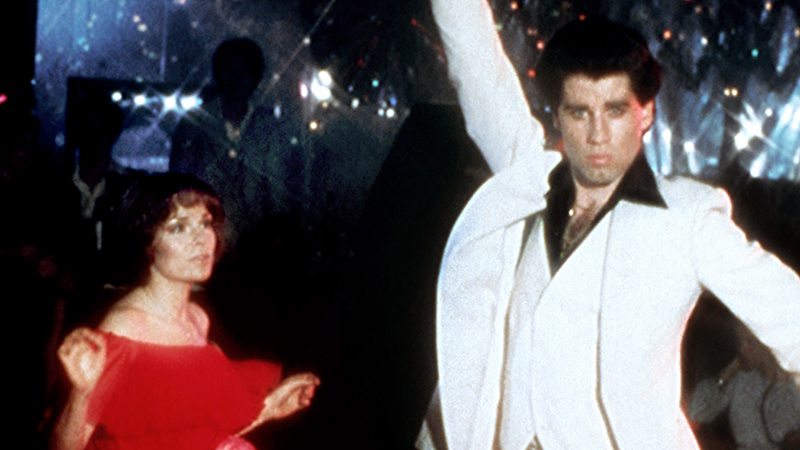
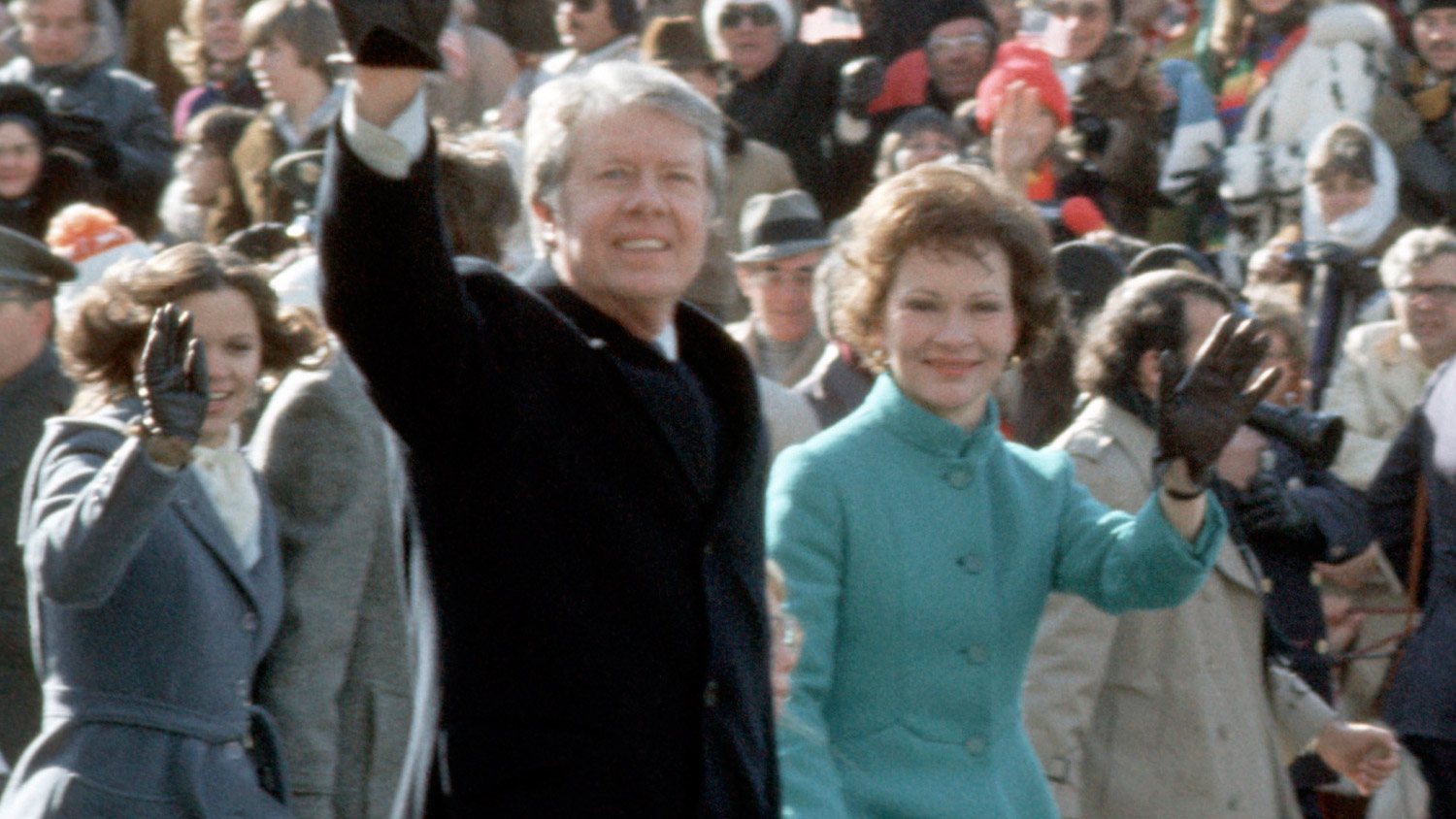
That year, Jimmy Carter was in the White House.
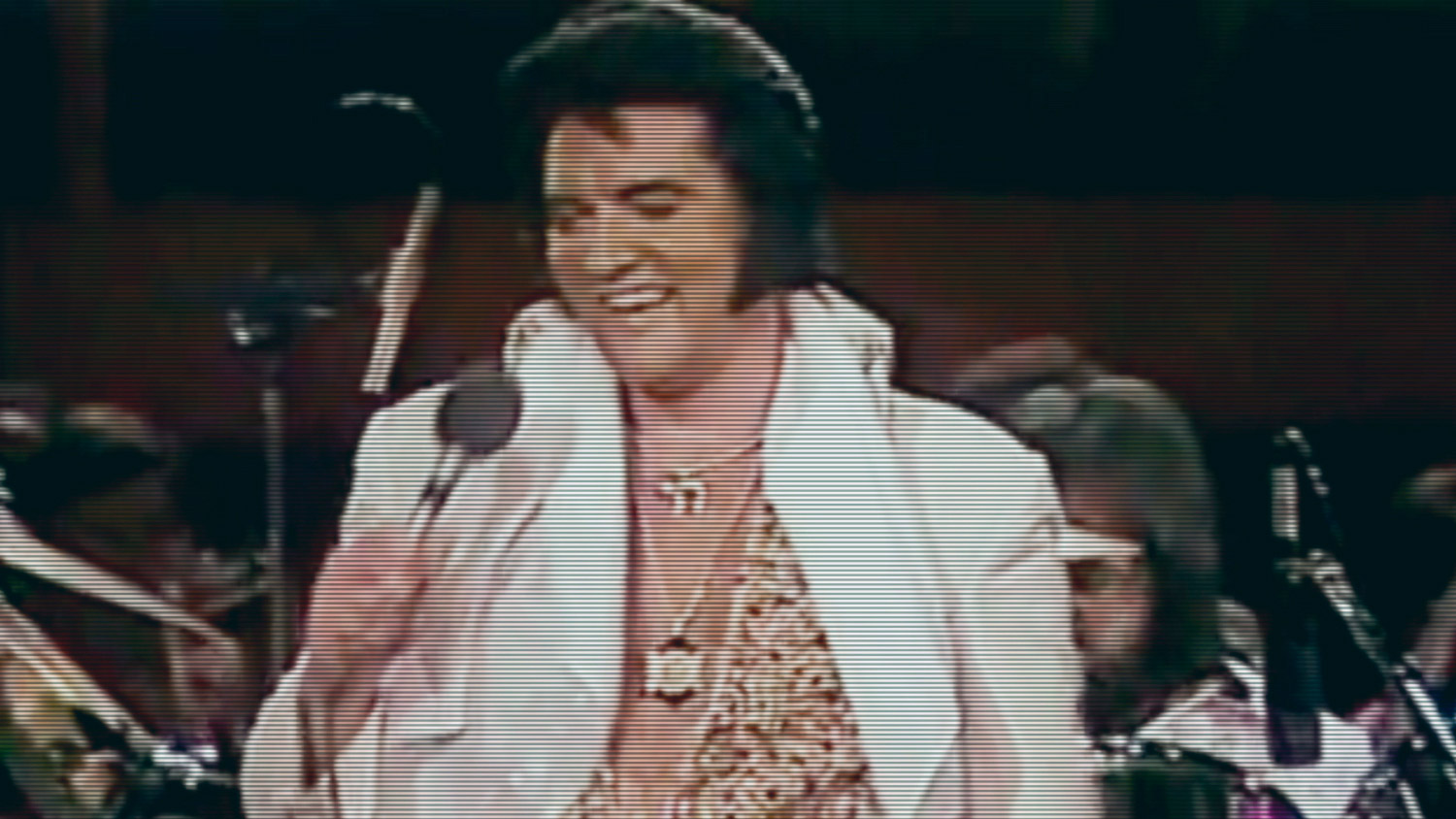
Elvis Presley gave his last performance at the Market Square Arena in Indianapolis.
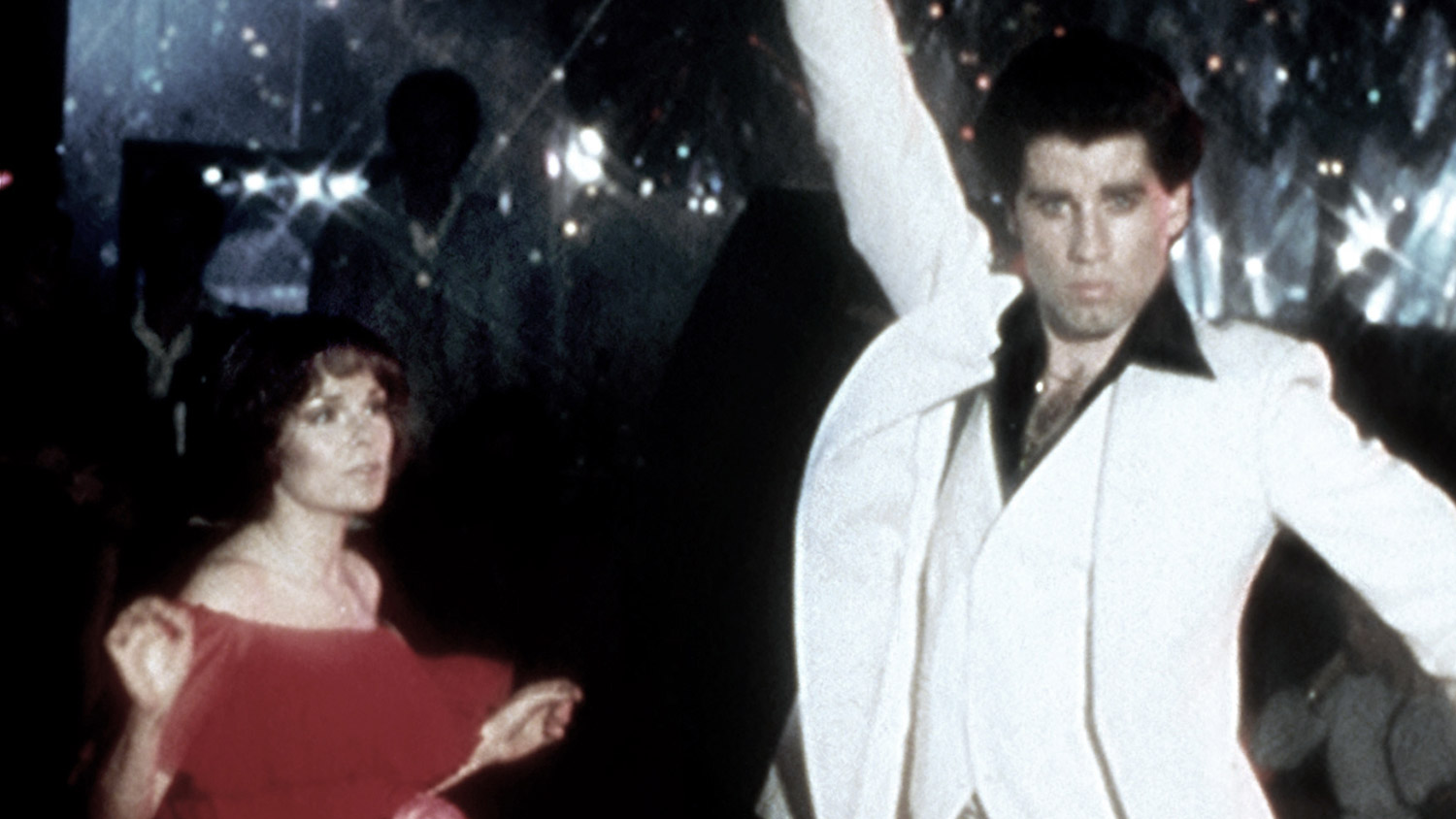
Saturday Night Fever hit in the theaters.
On the long, strange trip they started that year, the two Voyager spacecraft would reveal that the moons orbiting Jupiter were worlds in their own right, that Saturn's fabled rings boasted intricate weaves, and that Earth was but a pale blue dot set in the vastness of space.
NASA scientists believe that Voyager 1 reached a goal without precedent—interstellar space, the uncharted sea beyond the planets, the realm of stars—on August 25, 2012. The spacecraft had far outstripped Voyager 2, which trailed its twin by more than 300 million miles (483 million kilometers).
Until Voyager 1's feat, "all spacecraft, everything, all the planets, had been immersed in the solar wind, the wind from the sun," says Ed Stone, the rangy, 78-year-old Caltech professor who has headed the Voyager 1 and 2 science team for its entire 37 years of space exploration.
Voyager 1 found a distict change of neighborhood in interstellar space, where ashes from long-vanished stars float every three or so inches. It was an environment with more particles than the solar wind, the stream of charged particles forever racing off the sun's surface and into space.
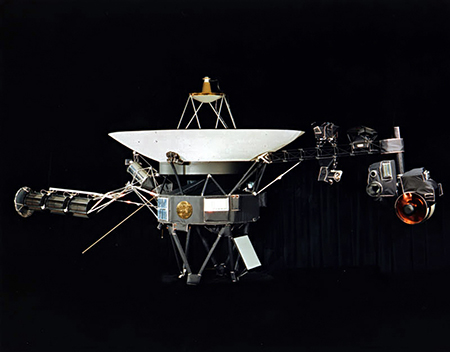 Traveling
more than 38,000 miles per hour (61,000 kilometers per hour), Voyager 1
dashes through interstellar space now as easily as it plunged past the
planets.
Traveling
more than 38,000 miles per hour (61,000 kilometers per hour), Voyager 1
dashes through interstellar space now as easily as it plunged past the
planets.
The spacecraft sends staccato messages via radio waves that take more than 17 hours to find their way home.
All told, Voyager 1 has traveled an arc of more than 16 billion miles (26 billion kilometers), past Jupiter's moons and Saturn's gleaming rings. Voyager 2 has sailed nearly as far and has visited Uranus and Neptune as well. No other spacecraft have revealed the secrets of so many worlds, roamed so far, or so profoundly reshaped our view of our home in the cosmos.
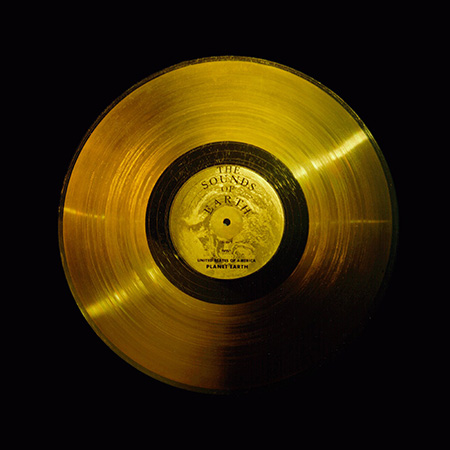 Both
vessels carry a copy of the "golden record," a 12-inch (30-centimeter),
gold-plated copper disk that is meant to act as a kind of Rosetta Stone
for any extraterrestrials seeking to understand life on Earth.
Both
vessels carry a copy of the "golden record," a 12-inch (30-centimeter),
gold-plated copper disk that is meant to act as a kind of Rosetta Stone
for any extraterrestrials seeking to understand life on Earth.
Behind the disk is a phonograph record containing sounds and images from Earth in the era of Saturday Night Live and Star Wars. "We were very lucky," Stone says. "Nature gave us a very nice solar system to explore."
Luck—or perhaps the serendipity of exploration, to be more exact—had indeed a lot to do with it.
Launch
John Casani, the mission's project manager, and Charley Kohlhase, Voyager mission adviser and navigation expert, watched from a Cape Kennedy control room as unwelcome readings reached them from the 15-stories-tall rocket climbing into space. Voyager 1 looked to be falling short. "I was scared. We were scared," Casani recalls.
Kohlhase turned to Casani, who was sitting next to him. "John, we may not be making it. We're not getting enough velocity."
Voyager 2 had already given Casani heartburn after its launch a few weeks earlier. (Despite the confusion it would create, NASA decided to launch 2 before 1, calculating that Voyager 1 would arrive at Jupiter ahead of its twin.) On Voyager 2's August 20, 1977, launch, the roll of the Titan IIIE rocket as it ascended had discombobulated the spacecraft's navigation system, triggering repeated "fail-safe" routines of the spacecraft's newfangled flight computer software, designed to look after spacecraft far from Earth.
Now with Voyager 1's launch, a tiny, initially undetected leak in a fuel line on the Titan's second stage was bleeding propellant from the massive rocket as it headed upward. Falling short meant that even if Voyager 1 made it into orbit, it wouldn't be high enough to successfully head on to its next destination, Jupiter.
"That was the whole mission, right there," Casani says. "There was nothing we could do about it—just watch."
But there was another surprise. They sat and waited for the spacecraft's third-stage Centaur rocket to coast partway around Earth to its final departure location, and then fire its engines one final time to achieve escape. The Centaur contained extra fuel, perhaps enough to make up the difference and get Voyager 1 onto the orbit it needed to begin visiting the outer planets. Casani knew, however, that burning all of a rocket's fuel might cause its empty fuel pumps to shred apart explosively.
The temperamental Centaur came within three seconds of fuel depletion, he says, before mercifully shutting itself off and sending Voyager 1 into the correct orbit, where it could fire yet another rocket stage, one built into the spacecraft, to send it to Jupiter.
"The only way I knew it was so close" to running out of fuel, says Casani, "was Charley Kohlhase telling me what was happening."
The Centaur's navigation system had been programmed to calculate how much firing it needed to reach the right orbit in flight, cut off from commands from the ground during its ascent. It had performed the corrective maneuver flawlessly on its own, burning an extra 1,200 pounds (544 kilograms) of propellant to make up the shortfall and achieve parking orbit.
Voyager 1's last-stage rocket fired without trouble, launching the spacecraft on its first leg of the trip to Jupiter and Saturn, while its twin, Voyager 2, was poised to take a "Grand Tour" of the solar system, an idea centuries in the making.
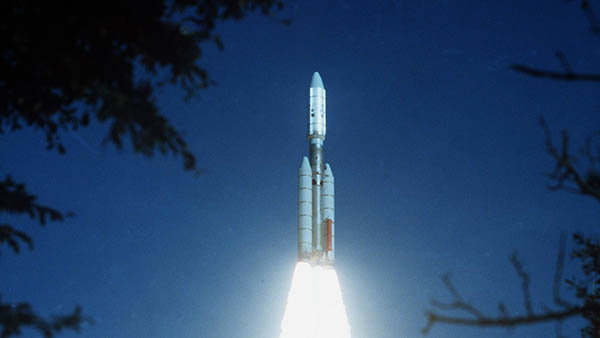
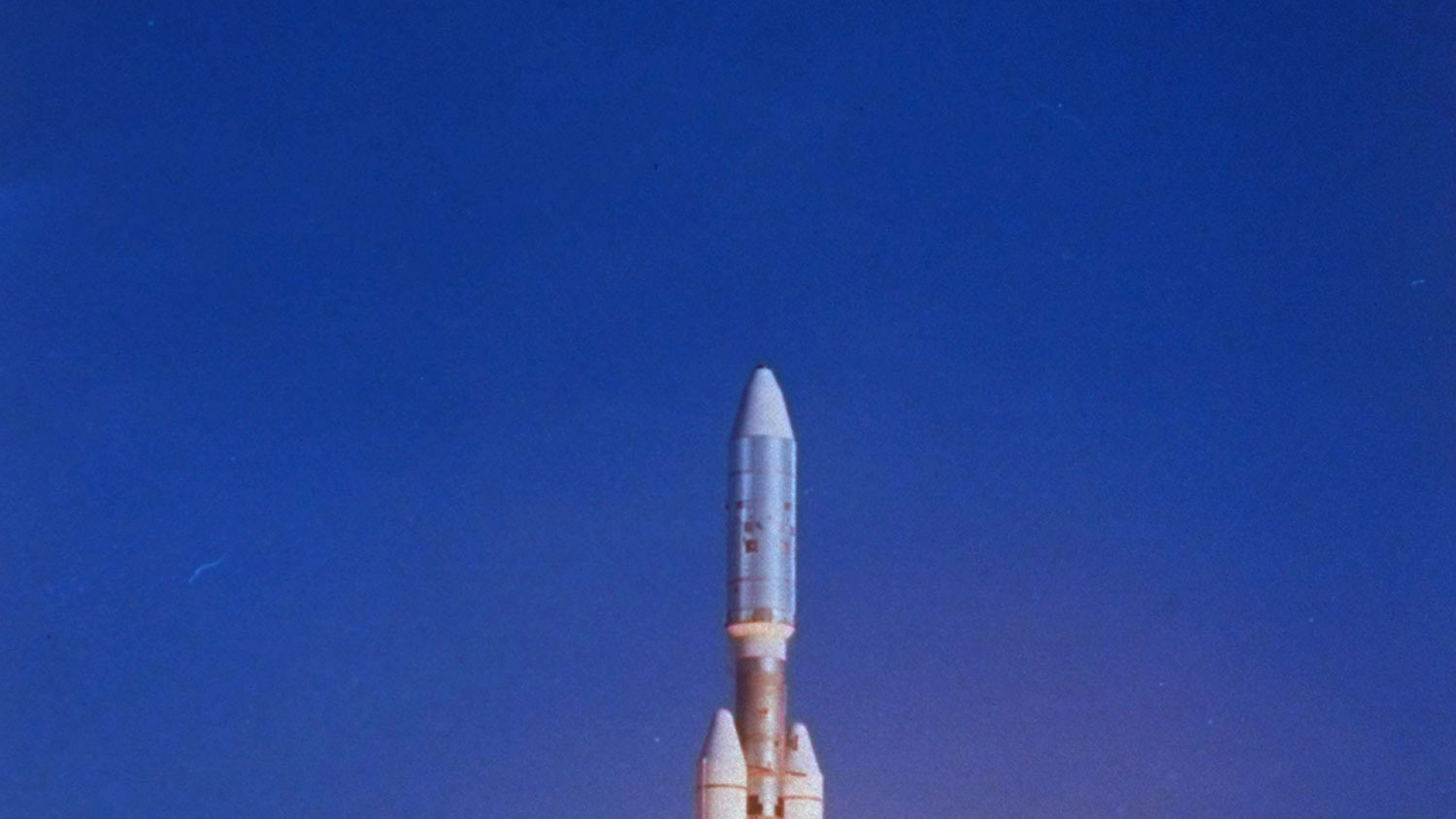
Voyager 1's last-stage rocket fired without trouble, launching the spacecraft on its first leg of the trip to Jupiter and Saturn,
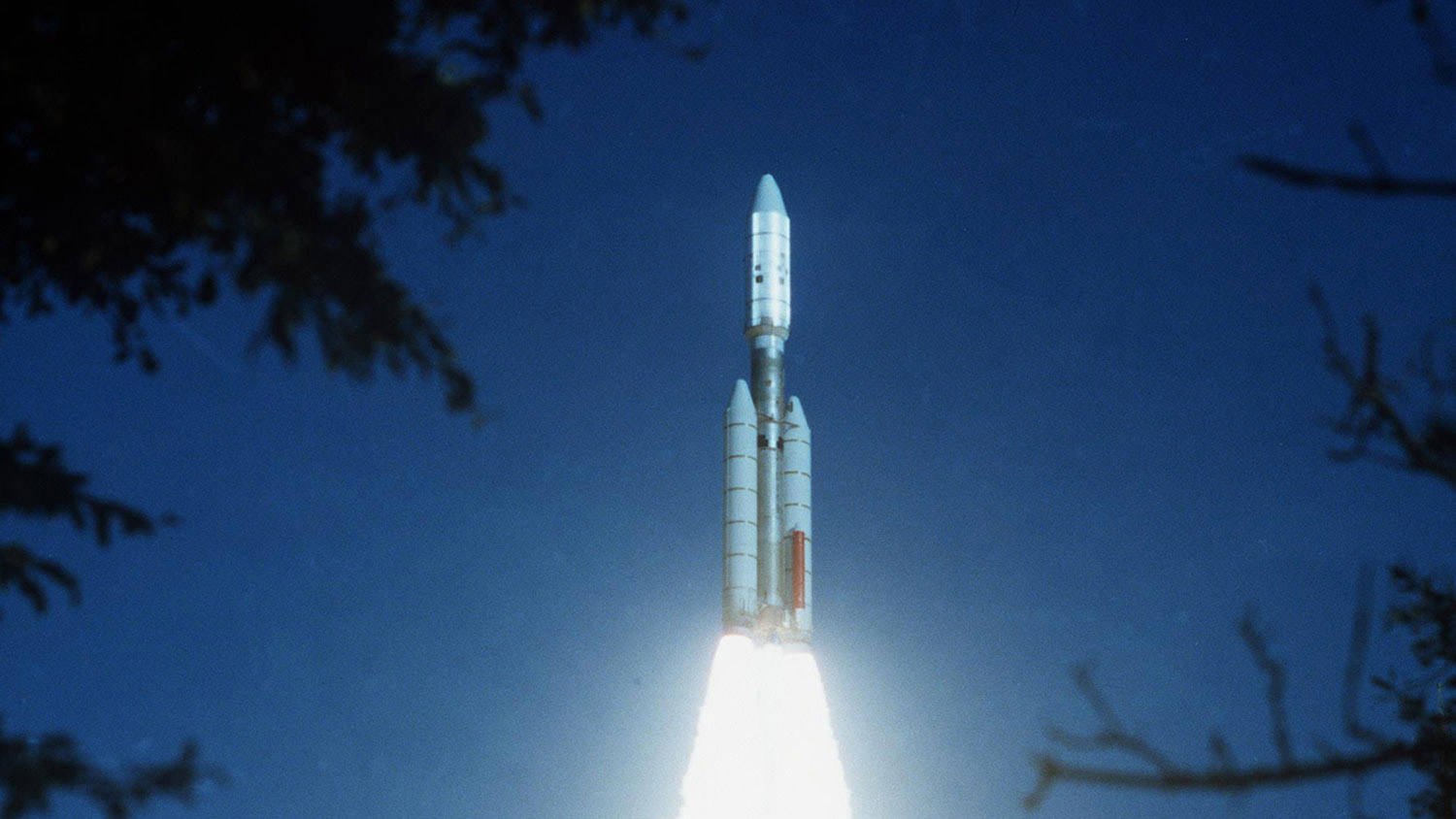
while its twin, Voyager 2, was poised to take a "Grand Tour" of the solar system,
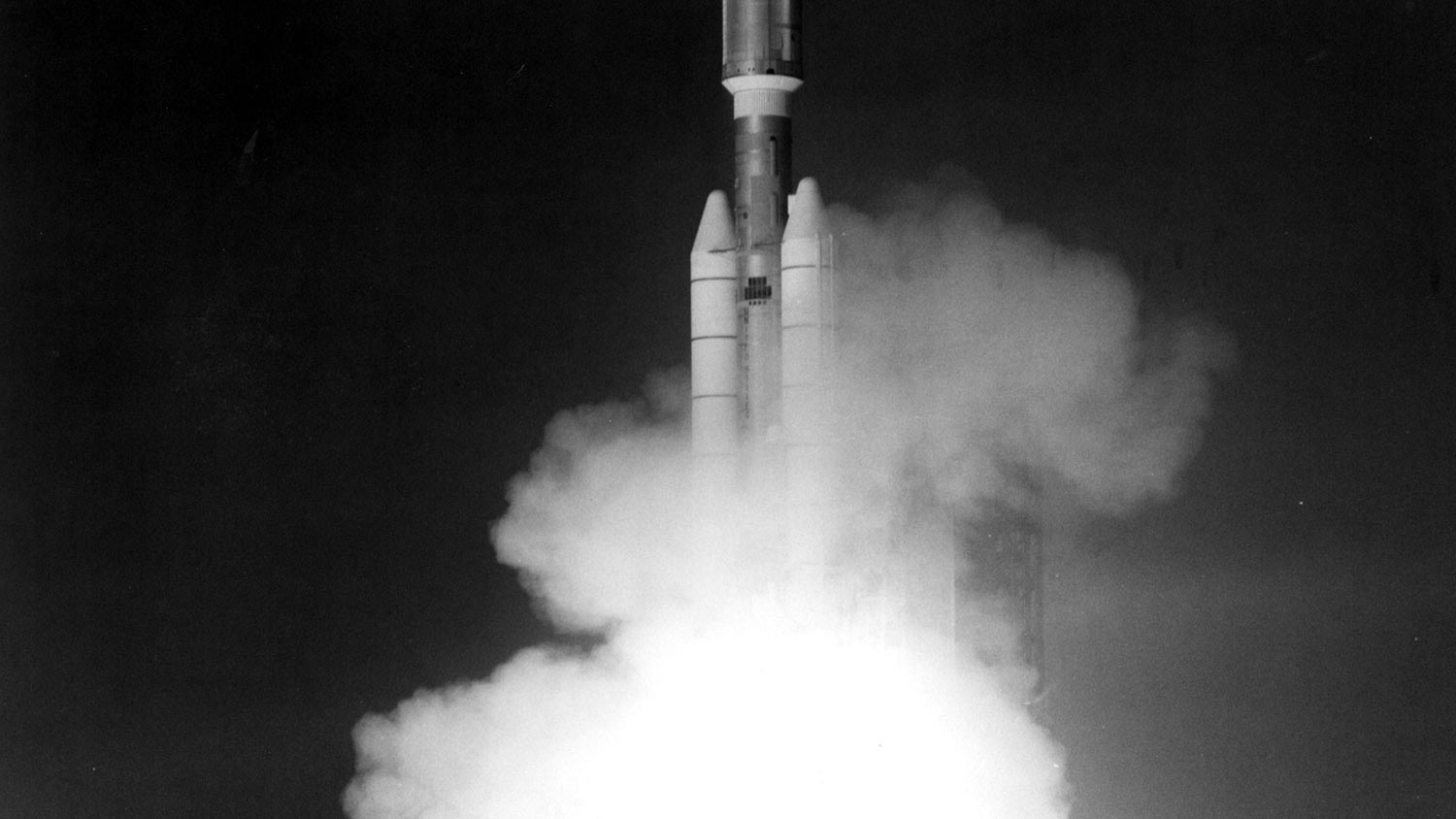
an idea centuries in the making.
The Grand Tour
Astronomy's patron saint, Galileo Galilei, first wrote in 1610 about his discovery of moons orbiting Jupiter. "Infinite thanks to God," he wrote, "for being so kind as to make me alone the first observer of marvels kept hidden in obscurity for all previous centuries."
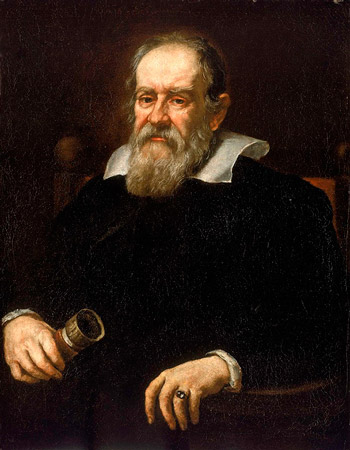 Earning
Galileo the attentions of the Roman Inquisition, his discovery of four
satellites circling Jupiter in the sky dealt a deadly blow, albeit a
long-delayed one, to the belief that the Earth was the center of the
cosmos.
Earning
Galileo the attentions of the Roman Inquisition, his discovery of four
satellites circling Jupiter in the sky dealt a deadly blow, albeit a
long-delayed one, to the belief that the Earth was the center of the
cosmos.
The Grand Tour taken by the Voyager spacecraft, however, owes its origins more closely to another astronomer, Johannes Kepler, who in 1614 suggested the names for the four largest moons of Jupiter that we know today: Io, Europa, Ganymede, and Callisto, mythological paramours of the King of the Gods.
To Kepler we also owe the simple, elegant mathematical laws that explain how planets sweep around stars and how spacecraft can tour the planets.
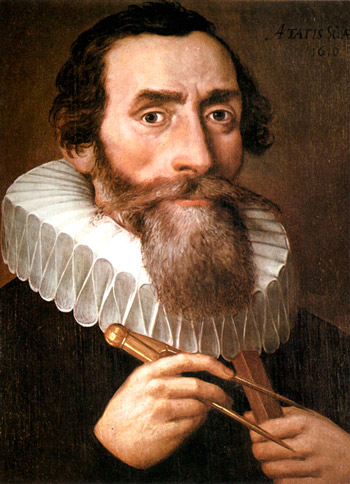 In his 1609 magnum opus, Astronomia Nova,
Kepler first described the curving geometry, circles and ellipses,
followed by planets as they circumnavigate the sun and by moons as they
loop around planets.
In his 1609 magnum opus, Astronomia Nova,
Kepler first described the curving geometry, circles and ellipses,
followed by planets as they circumnavigate the sun and by moons as they
loop around planets.
This early view of the heavens was developed over the centuries with a big lift from Isaac Newton, whose geometric findings describe the arcs traced by comets, and later by spacecraft.
"We could launch as far as Jupiter; we could not launch farther," says Kohlhase, without a simple but ingenious trick pointed to by Kepler's laws: the "gravity assist" that allowed the planet-hopping trajectories pursued by Voyager 1 and 2.
Those new trajectories were the handiwork of a UCLA graduate student named Michael Minovitch who in 1961 wrote a technical memo called "A Method for Determining Interplanetary Free-Fall Reconnaissance Trajectories." In it, he boldly proposed for the first time to steer from planet to planet by using the gravity of each world to serve as the spacecraft's rudder and sails.
As a demonstration, he showed how to send a spaceship from Earth to Venus to Earth to Mars to Saturn to Pluto to Jupiter to Earth without burning a drop of fuel. To a rider on that spaceship, it would seem like the vessel was simply falling from one planet to the next.
"If you launched a cannonball at the right speed, with the right navigation, it would swing by Jupiter, by Saturn, by Uranus, and by Neptune," Kohlhase says.
By the same token, when a tiny spacecraft nears a planet, the two objects engage in a gravitational tug of war. As usually happens in such contests, the big guy wins and the little guy goes flying. In the case of a spacecraft passing in the wake of a planet as it circles the sun, the gravity assist adds to its velocity relative to the sun and changes its direction. The flyby of Jupiter done by both Voyager spacecraft added about 22,000 miles (35,400 kilometers) per hour to their speed relative to the rest of the solar system, and sent them into sharp left turns toward Saturn.
The energy for this assistance comes at a tiny cost, a transfer of planetary inertia to the spacecraft that would cause less than a trillionth of a mile per hour decrease in the speed of the King of Planets as it circled the sun.
There is one catch. "The planets have to be in a certain alignment," Kohlhase says. "If you want to use gravity assists to go from Earth to Jupiter to Saturn to Uranus to Neptune, that happens every 176 years."
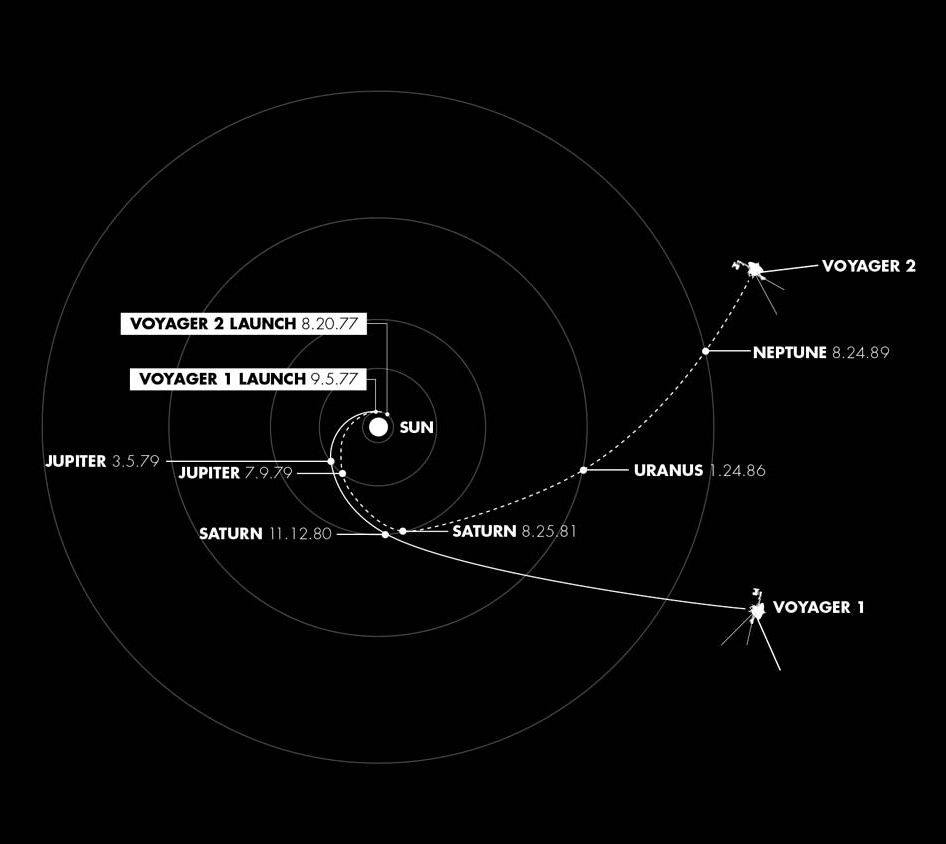
A rare planetary alignment offered gravity assists that cut the mission time by nearly 20 years.
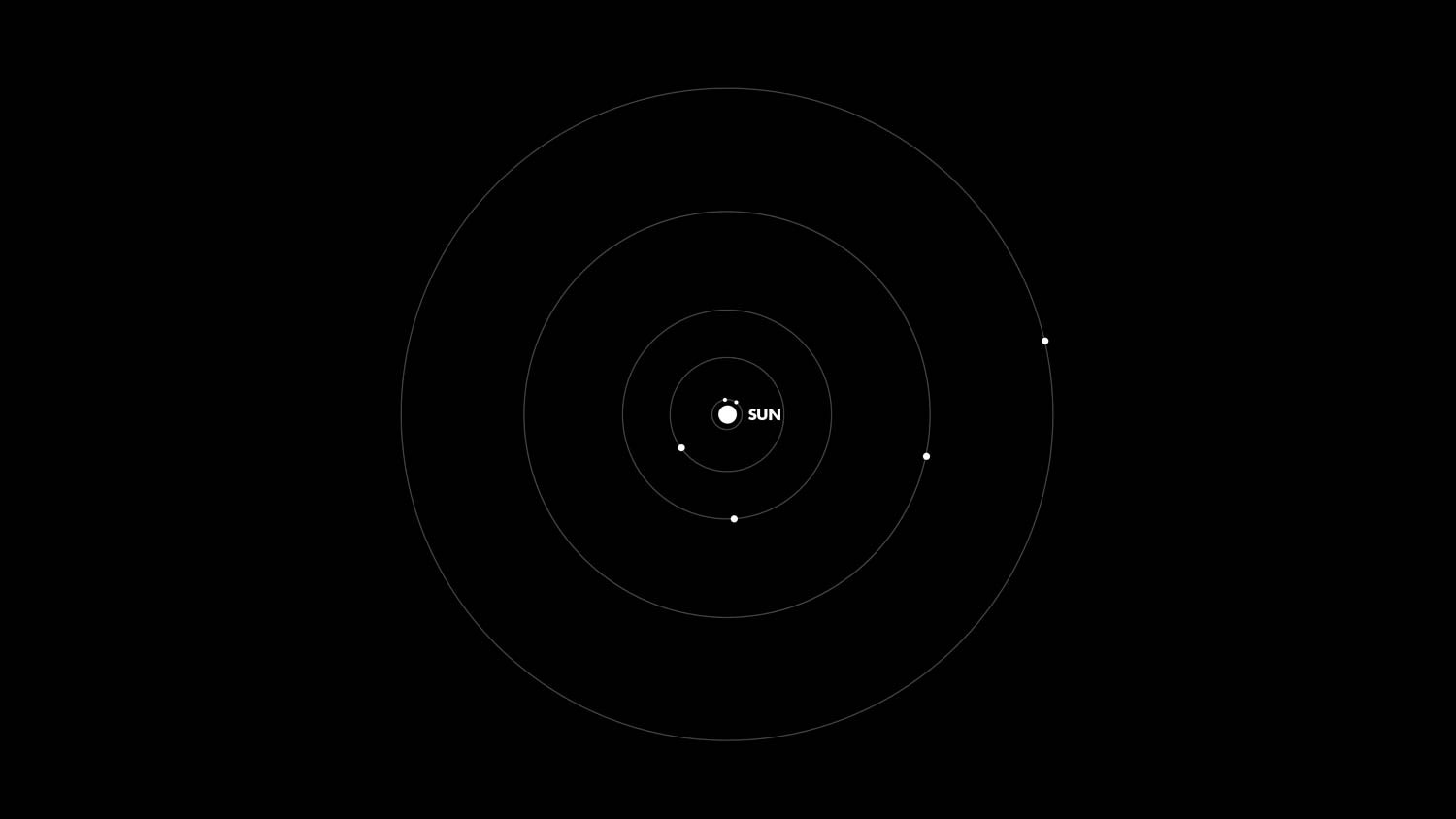
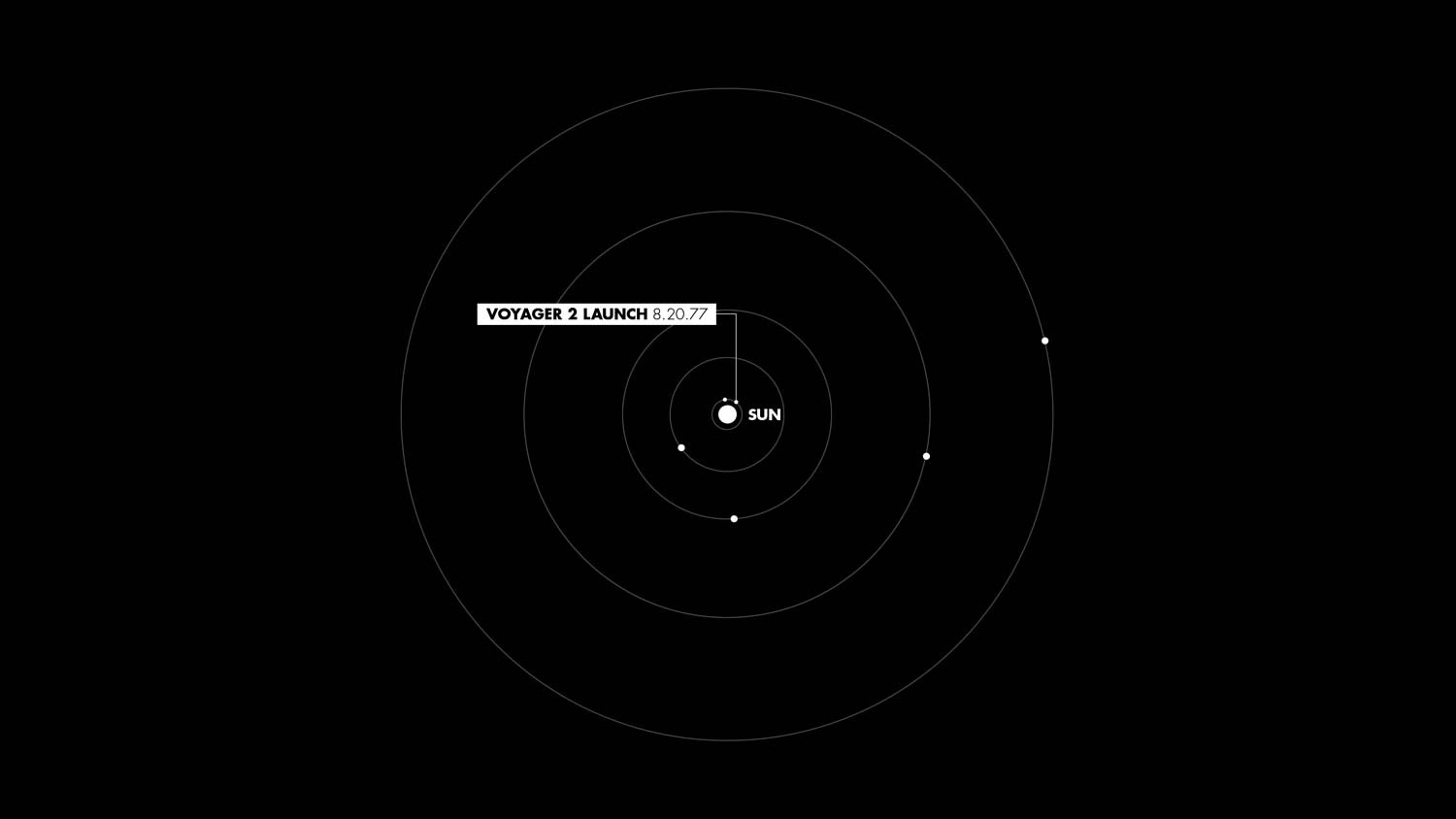
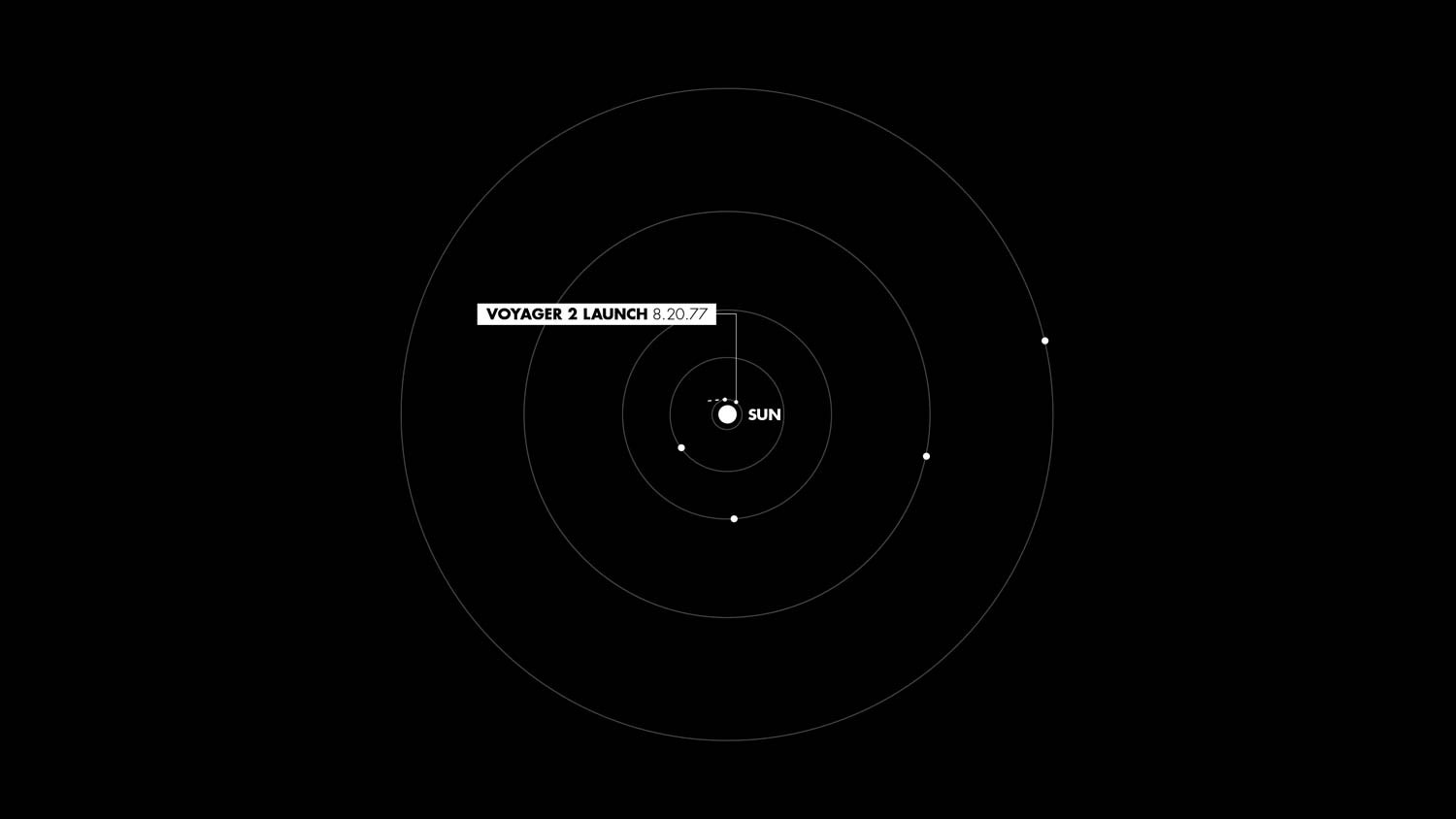
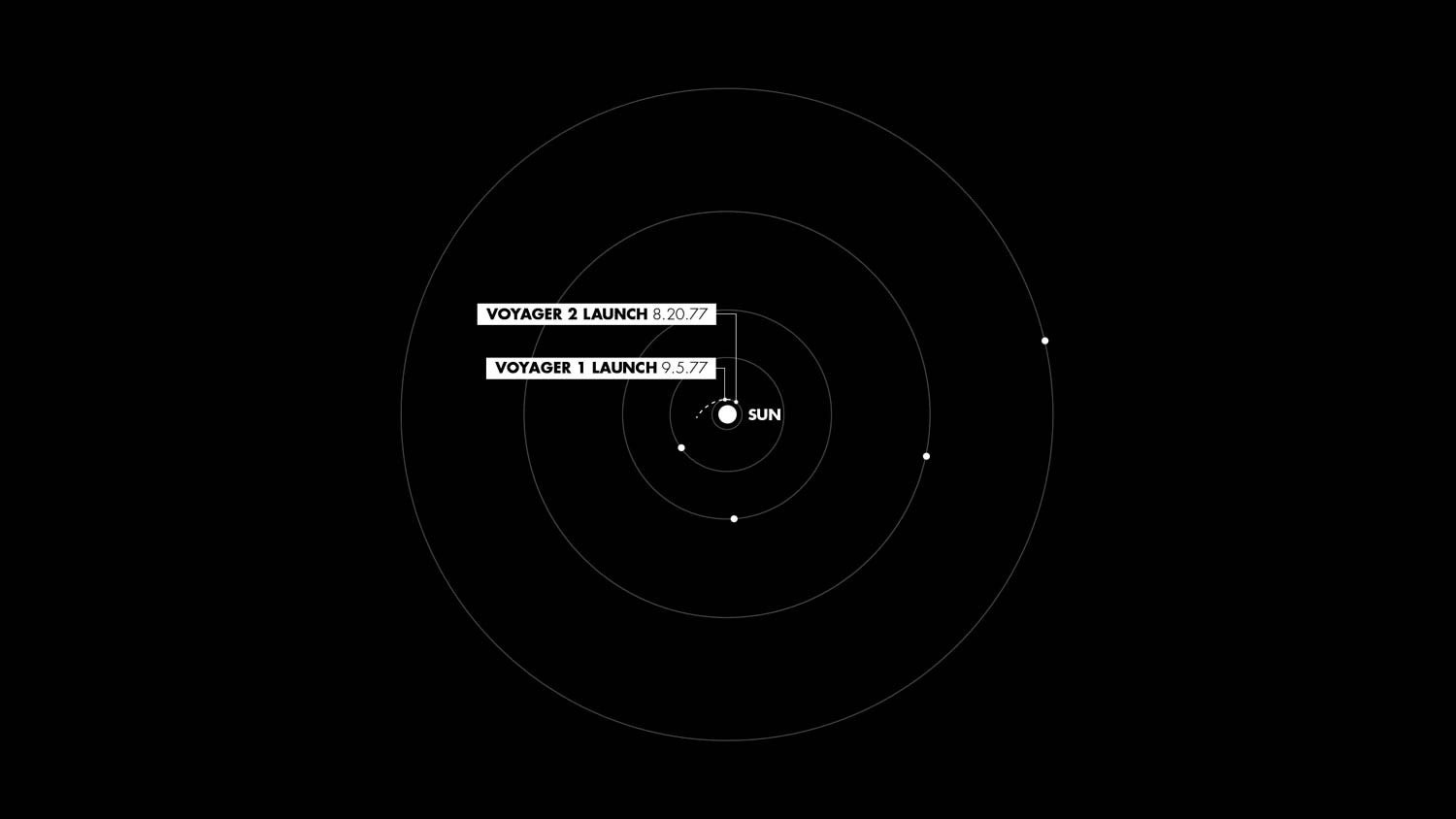
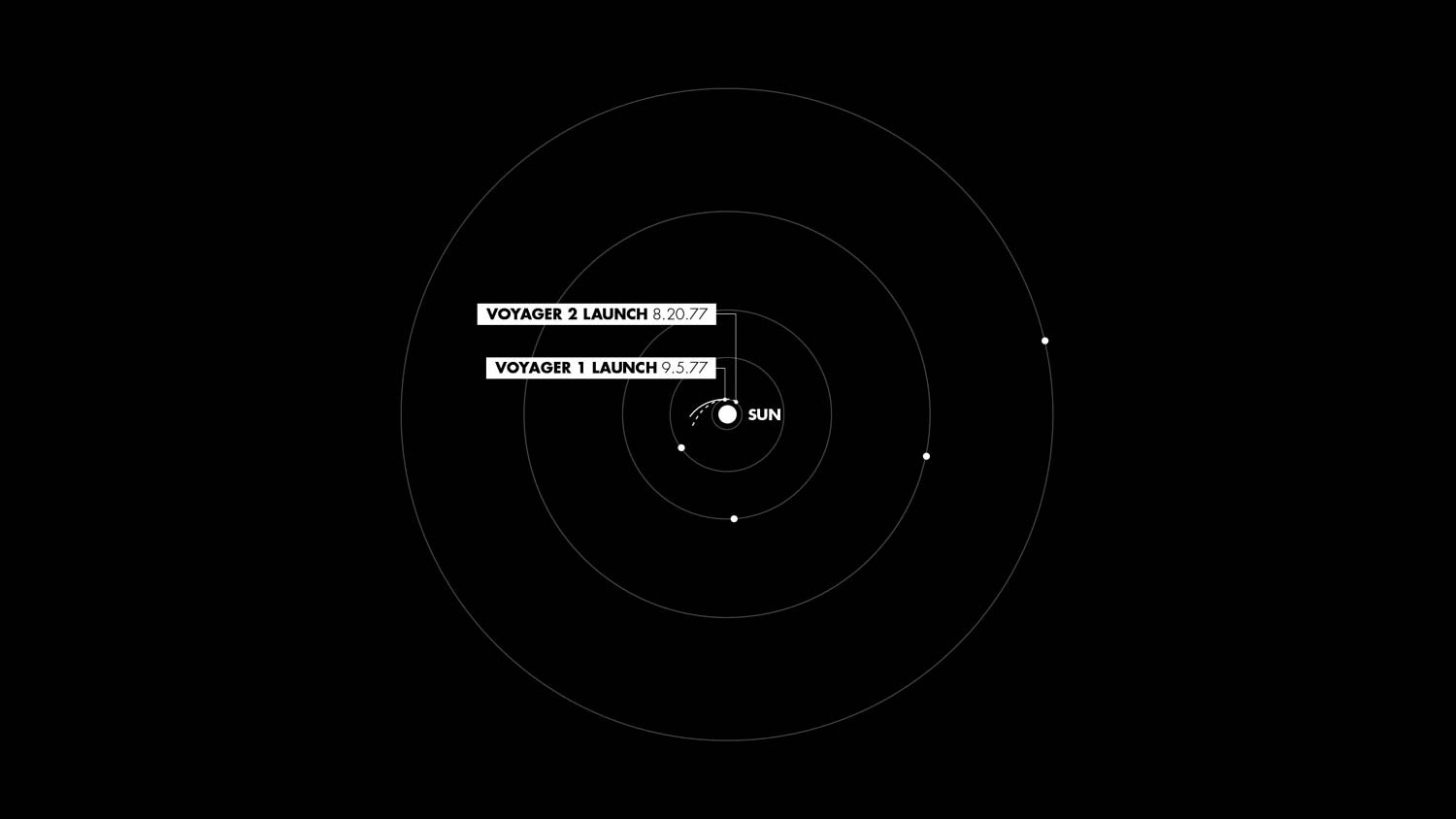
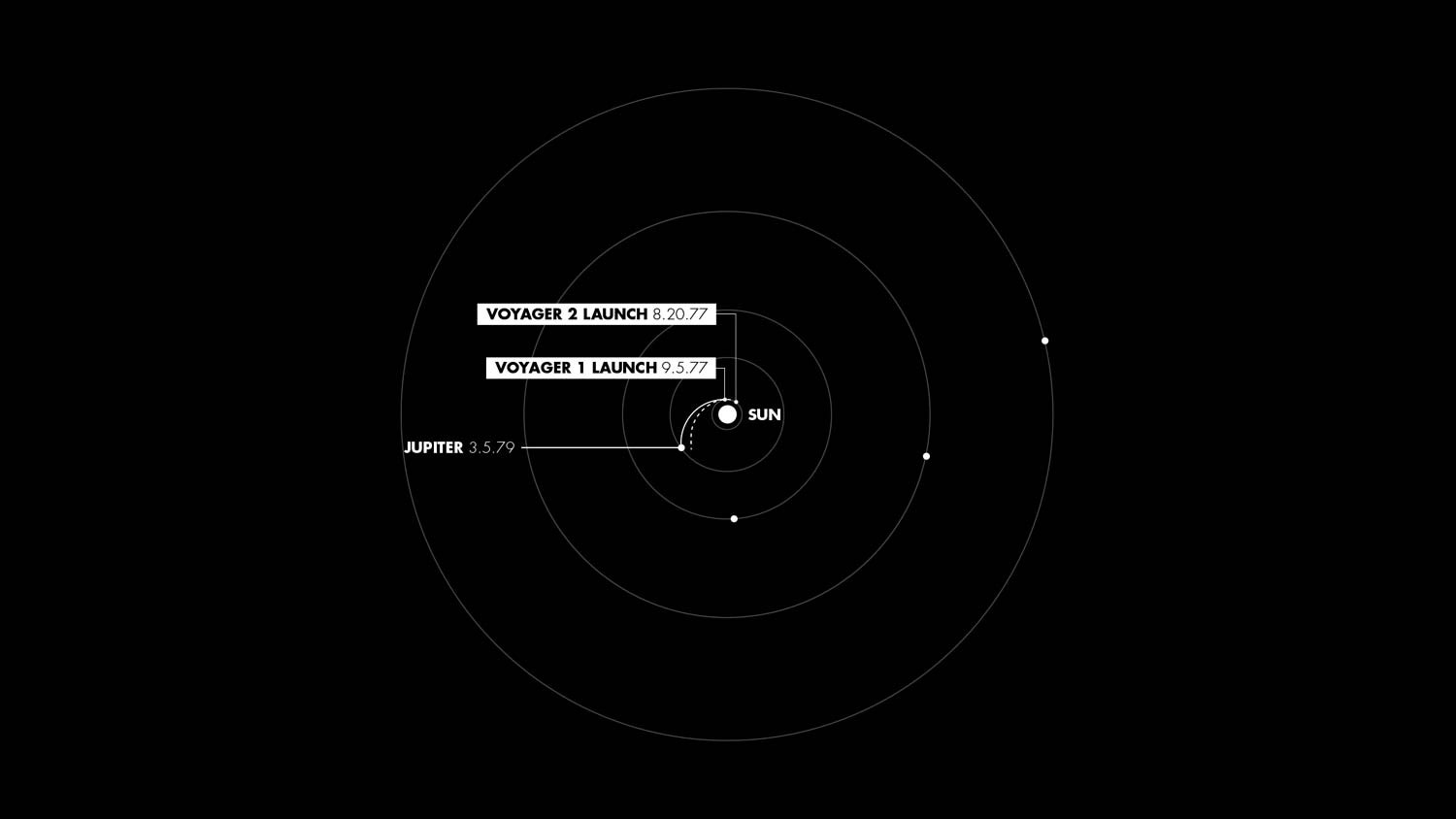
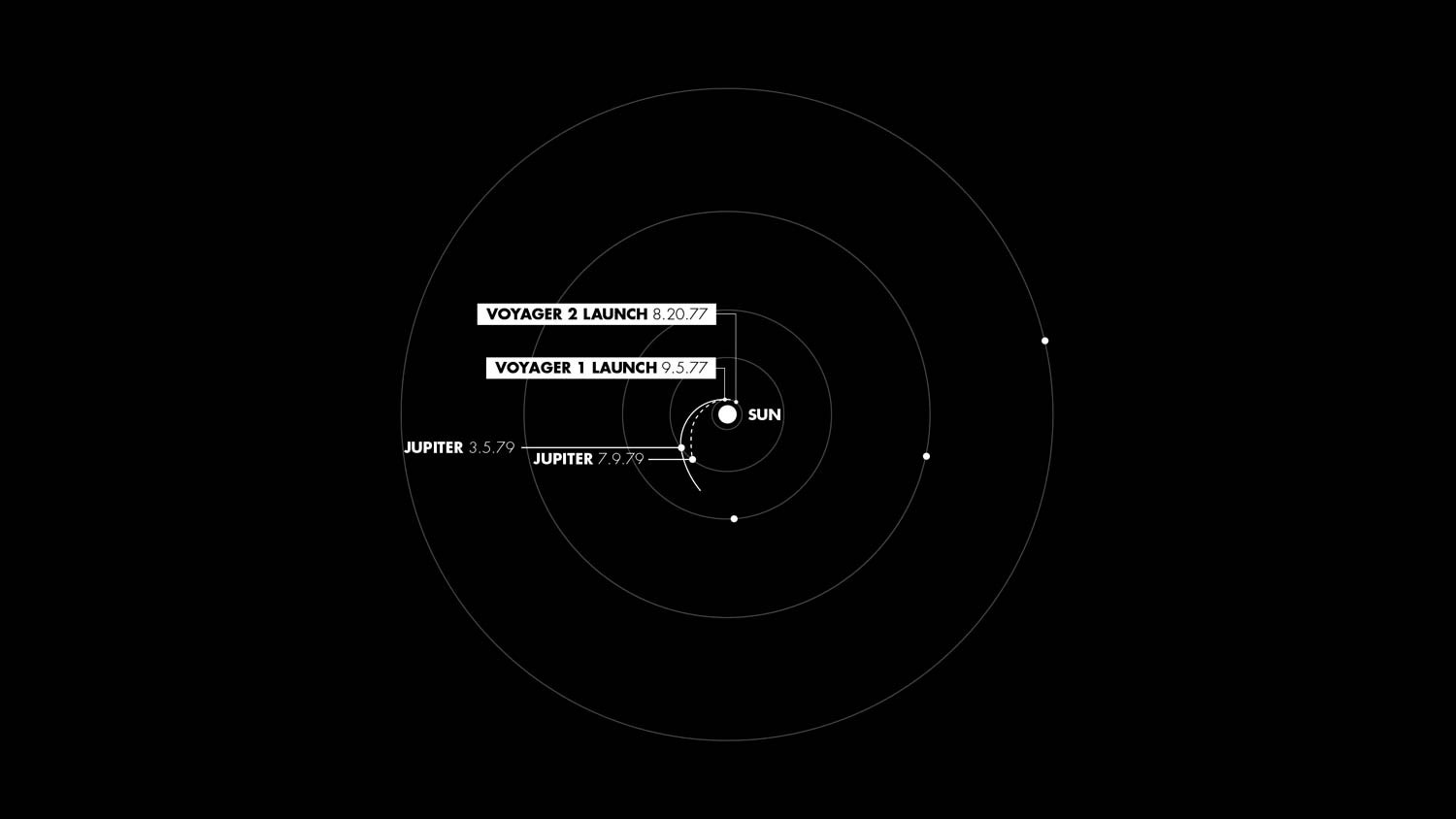
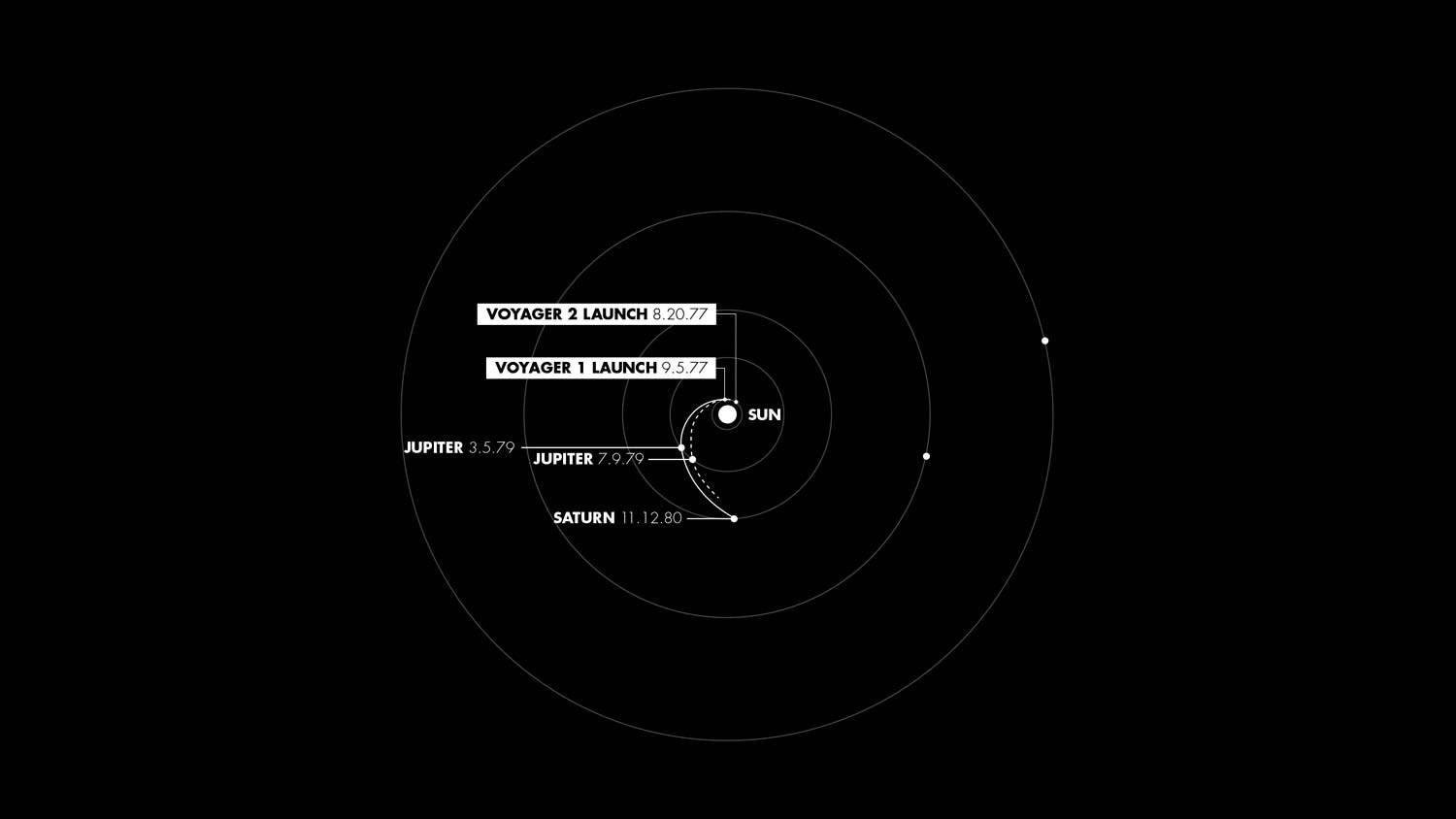
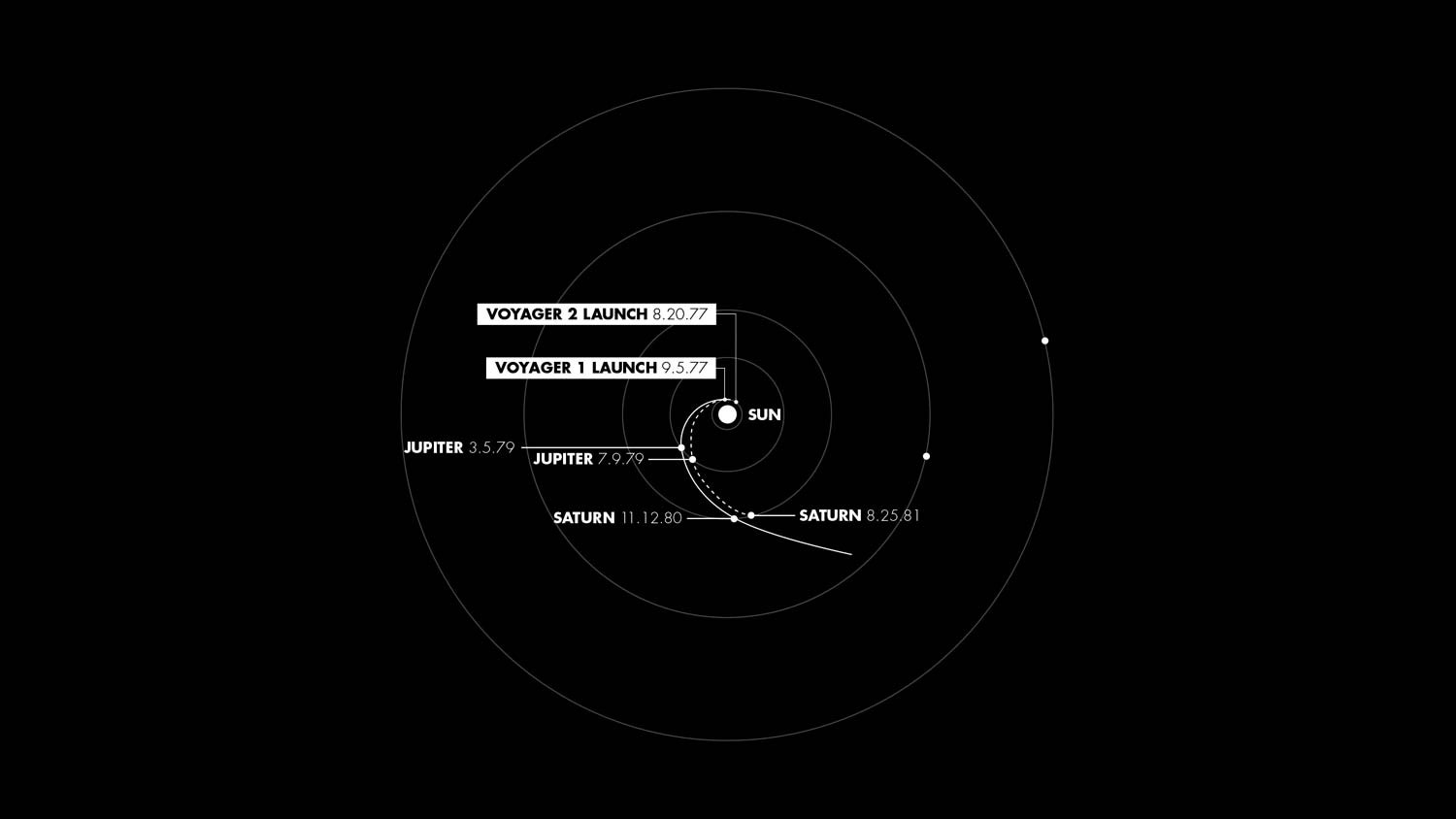
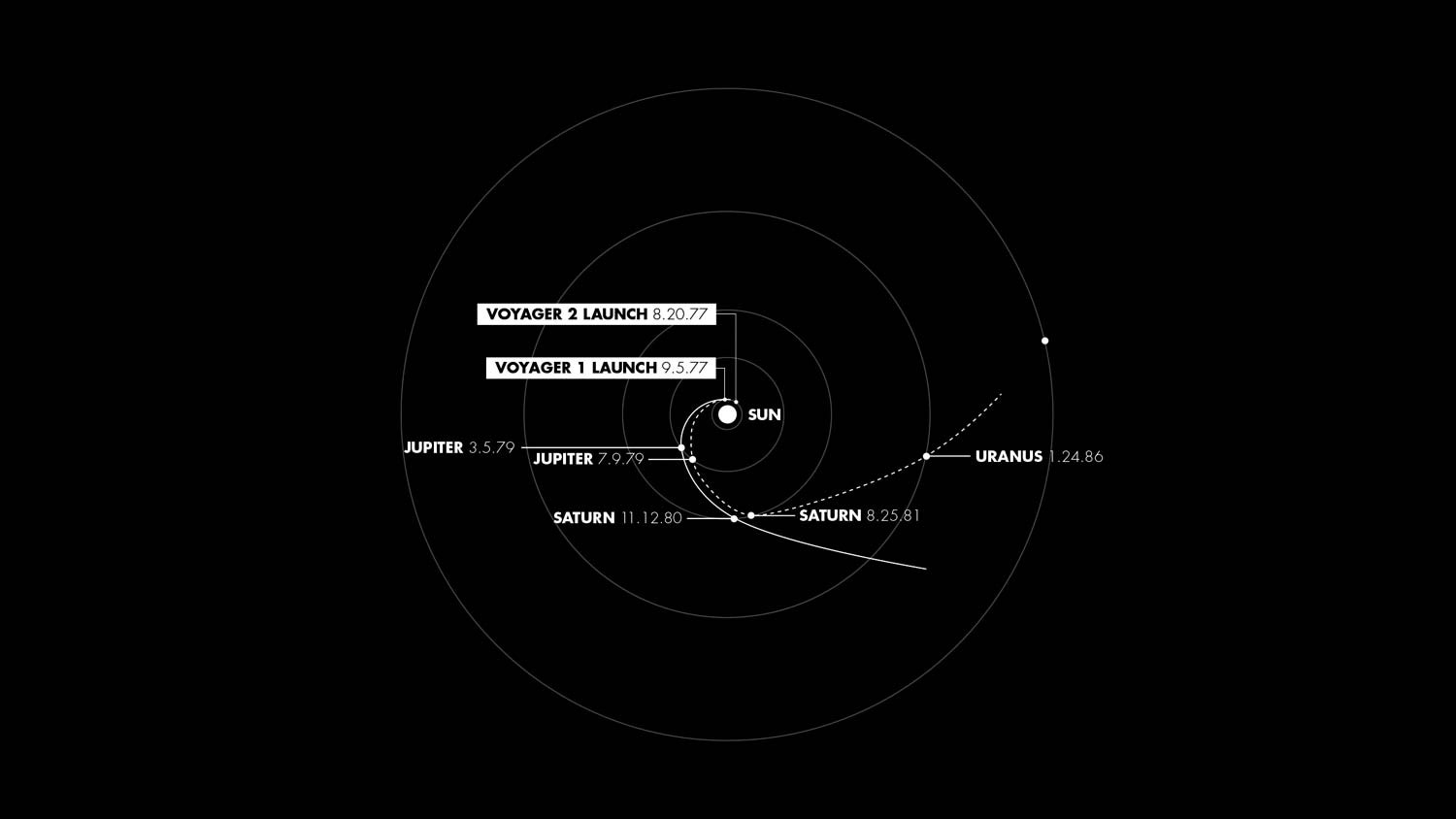
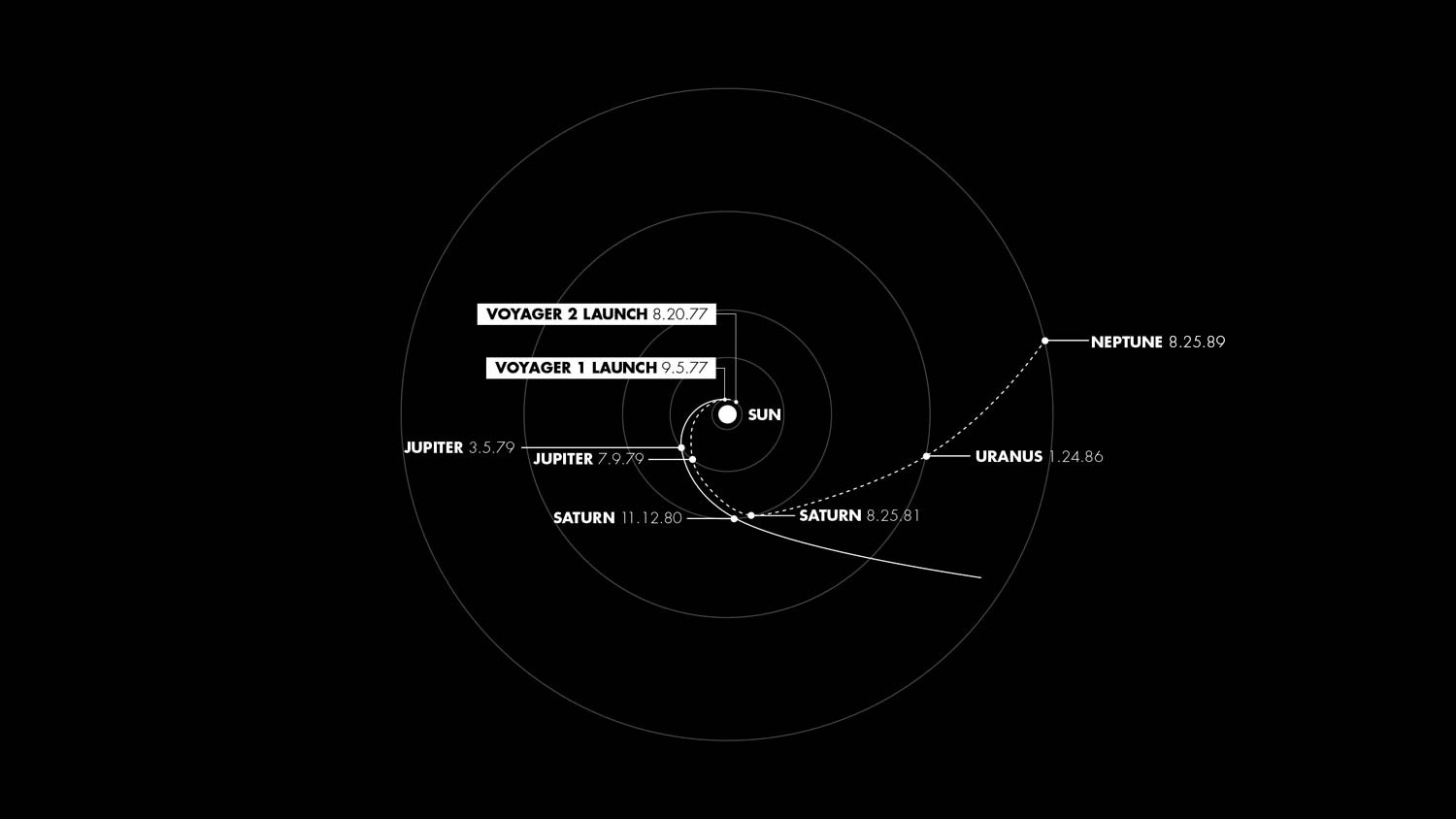
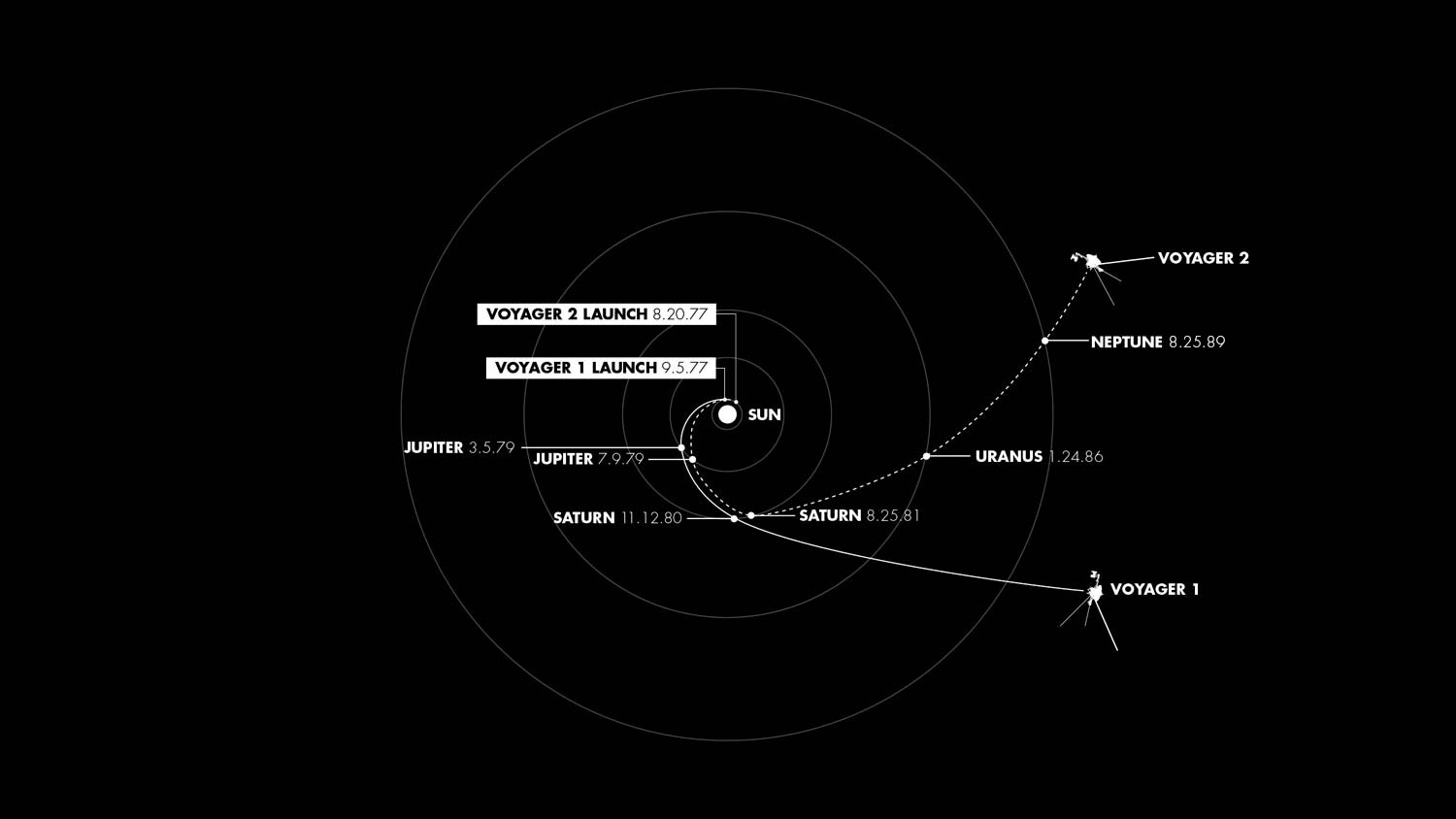
A rare planetary alignment offered gravity assists that cut the mission time by nearly 20 years.
By the late 1960s, space mission planners at NASA knew that the right alignment was coming but would last for only three years. ("The 'Goldilocks Year' was 1977," Kohlhase says, offering the just-right alignment of the outer planets needed for gravity assists.) In addition to saving fuel, the speed boost provided by gravity assists could cut the mission's duration to less than nine years, instead of the 30 or more years needed to reach Pluto using a conventional spacecraft trajectory.
JPL and, soon enough, the public were keenly aware of the opportunity for a Grand Tour presented by the alignment, Kohlhase says. "The last time it happened before the 1977 launch was 1801. That was three years before the first locomotive." (Some of the awareness came to a giddy head with The Jupiter Effect, a 1974 best-seller that prophesied catastrophes, such as a gigantic earthquake along California's San Andreas Fault, resulting from the planetary alignment.)
 As the world
watched astronauts land on the moon during the space agency's Apollo
missions from 1969 to 1972, National Research Council panels and JPL
mission planners pondered the Grand Tour mission—first proposed in
1966—to explore the outer planets of the solar system.
As the world
watched astronauts land on the moon during the space agency's Apollo
missions from 1969 to 1972, National Research Council panels and JPL
mission planners pondered the Grand Tour mission—first proposed in
1966—to explore the outer planets of the solar system.
JPL's proposed five-spacecraft Outer Planet Grand Tour mission would have included two Jupiter-Saturn-Pluto trips, two Jupiter-Uranus-Neptune trips, and a Jupiter orbiter. Some of the spacecraft would be powered by nuclear rockets, which would cut trip times to Pluto from nine years to six.
Those plans largely fell victim to NASA budget cuts as the moon race ended, says space historian John Logsdon, author of John F. Kennedy and the Race to the Moon. Recognizing the coming cuts, the Space Science Board of the National Academy of Sciences advised against the $750 million Grand Tour plan in a 1971 report.
"Just too expensive," Stone says, summarizing the report's conclusion. With the costs spiraling, NASA canceled the Grand Tour plan at the end of that year.
"JPL came back and said, 'OK, we'll start smaller,'" Casani says.
The result was Mariner-Jupiter-Saturn 77 (MJS-77), a four-year plan to send two smaller spacecraft from the successful Mariner line of missions, which had already visited Mars, Venus, and Mercury, on to the next farther planets, Jupiter and Saturn.
"We were trying to capitalize on Mariner because it had been so successful," says Casani, who was made program manager for Voyager in 1977.
One sticking point for him was the mission's name. "I said, 'Who the hell cares about what year we launched the mission? We need a nice, crisp name,'" says Casani. "So we held a contest." A case of champagne was the reward for the winner.
"That's how it got to be Voyager, instead of MJS-77."
All the while, those mission planners were still thinking about how to travel beyond Saturn. Anything that would unnecessarily terminate the mission at Saturn was scrapped.
On a previous Mariner mission, for example, a navigations tracker had just barely kept sight of Earth well enough to allow a Venus mission to succeed. Similar Earth trackers were planned for Voyager. "The navigation team told us that they were pretty sure it would get us to Saturn, but it would be touch and go," Casani says.
"I don't want touch and go; I had enough of touch and go at Venus," he says. "I told them I want to go to Neptune and Pluto."
At the same time, they had to stay low-key. Casani's boss, Bud Schurmeier, the $320 million mission's original program manager, yelled at him for adopting a phone extension with its final four digits spelling out "MJSU."
"He told me we have to be careful with Congress, because they had barely approved the mission. And they don't want to hear about Uranus," Casani says.
"Nobody is going to care about a phone number, I told him. And they didn't. That was my phone number until the day I retired."
By 1976, NASA headquarters "became more warmly disposed" to the possibility of a Uranus flyby, according to Henry C. Dethloff and Ronald A. Schorn, authors of Voyager's Grand Tour: To the Outer Planets and Beyond, after the space agency found it couldn't convince Congress to fund a third Voyager mission to that planet.
The reason for having two spacecraft was simple, Kohlhase says: safety. One was a spare in case the first failed to properly observe Saturn's enigmatic moon, Titan. The second largest moon in the solar system, wider than Mercury, Titan was the only one swathed in its own thick atmosphere. The curious, dense haze fascinated and puzzled the mission's scientists and played a major role in the shaping of the Voyager mission.
In fact, if Voyager 1 missed its mark in peering at Titan, the idea was that Voyager 2 would alter its path to ensure an investigation of the moon, even at the cost of forestalling a trip to Uranus and Neptune.
Two spacecraft allowed the mission to look at all four Jovian moons, both from the front side and the back side, coming and going from the planet. Similar views could be gained of some of Saturn's moons.
Also, "we didn't want to send both spacecraft too close to Jupiter," Kohlhase says. On the first-ever flyby of the planet in 1973, the Pioneer 10 probe had revealed shockingly high amounts of radiation—one million times stronger than the levels in Earth's Van Allen radiation belts—emanating from Jupiter.
"If you had been riding on the spacecraft, you would have received 500 times the lethal dose," Kohlhase says. The radiation was strong enough to trigger a false command in Pioneer 10's onboard computer, which led to the loss of a close-up picture of the moon Io. The radiation was strong enough to darken the lens of the probe's asteroid and meteoroid detector.
It also scared the Voyager mission planners. "We did a lot of things to make the spacecraft more resistant to radiation" than the earlier probes were, Kohlhase says.
All the same, they kept Voyager 2 nearly twice as far away from Jupiter as its twin, just in case.
Such restrictions dictated by the science team were a blessing in disguise for the trajectory team. The advent of digital computers meant the trajectory team had 10,000 possible trajectories to choose from as they contemplated planetary passages, but they whittled the number down to 98 after consulting with the science team. And then to two, as the mission scientists honed in on the sights they absolutely could and couldn't live without on the trip. This paring down defined the paths finally followed by Voyager 1 and Voyager 2.
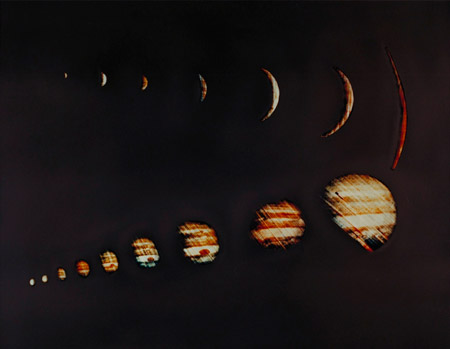 Pioneer 10's encounter with Jupiter, which produced about 500 photos, also taught the team one other lesson.
Pioneer 10's encounter with Jupiter, which produced about 500 photos, also taught the team one other lesson.
"Here was a room full of reporters, an auditorium full of reporters wanting to know what the scientists were learning: 'Please tell us. Please tell us,'" Stone says. "I thought, 'Wow, what an opportunity to share the whole process.'"
Maybe it was a sign of the times, but sharing the experience is just what they did.
The Outer Planets
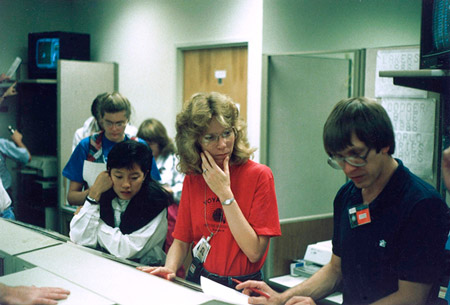 "I
got to launch my career, literally, with Voyager," says Linda Spilker
(pictured, in red). "Talk about something so inspiring, to actually be
there and watch."
"I
got to launch my career, literally, with Voyager," says Linda Spilker
(pictured, in red). "Talk about something so inspiring, to actually be
there and watch."
Fresh out of college and one of the newly hired women on the Voyager team, Spilker was drawn to the discoveries promised by the mission. Now a project scientist for the Cassini spacecraft mission orbiting Saturn today, she recalls that when Voyager 1 and Voyager 2 launched, not a lot was known about the outer planets of our solar system.
"If you looked in the astronomy books, they had a whole lot on Mars, but when you got to Jupiter and Saturn, especially when you got to Uranus and Neptune, they only had a little tiny bit."
Although Uranus was discovered in 1781 and Neptune in 1846, astronomers still didn't know a lot about the planets before the Voyager spacecraft visited them.
"It is truly astounding how very little we knew about the outer planets when we started," NASA imaging team chief Bradford Smith wrote in the August 1990 issue of National Geographic magazine, looking back on the trip after the Voyager 2 encounter with Neptune, the last planet visited on its tour.
Before the mission, Uranus and Neptune were drawn in textbooks as aquamarine fuzz balls with scant descriptions accompanying them. Uranus rolled on its side, unlike any other planet, but no one knew the length of its day, or of Neptune's.
Jupiter and Saturn were thought to be better understood: big, boring balls of gas, one adorned with a red spot and surrounded by crater-battered ice moons, the other encircled by uncomplicated rings built of snowballs the size of a Volkswagen minibus.
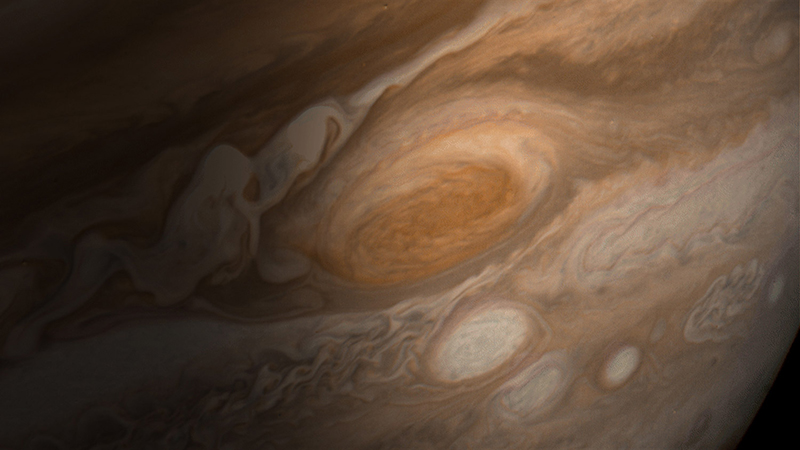
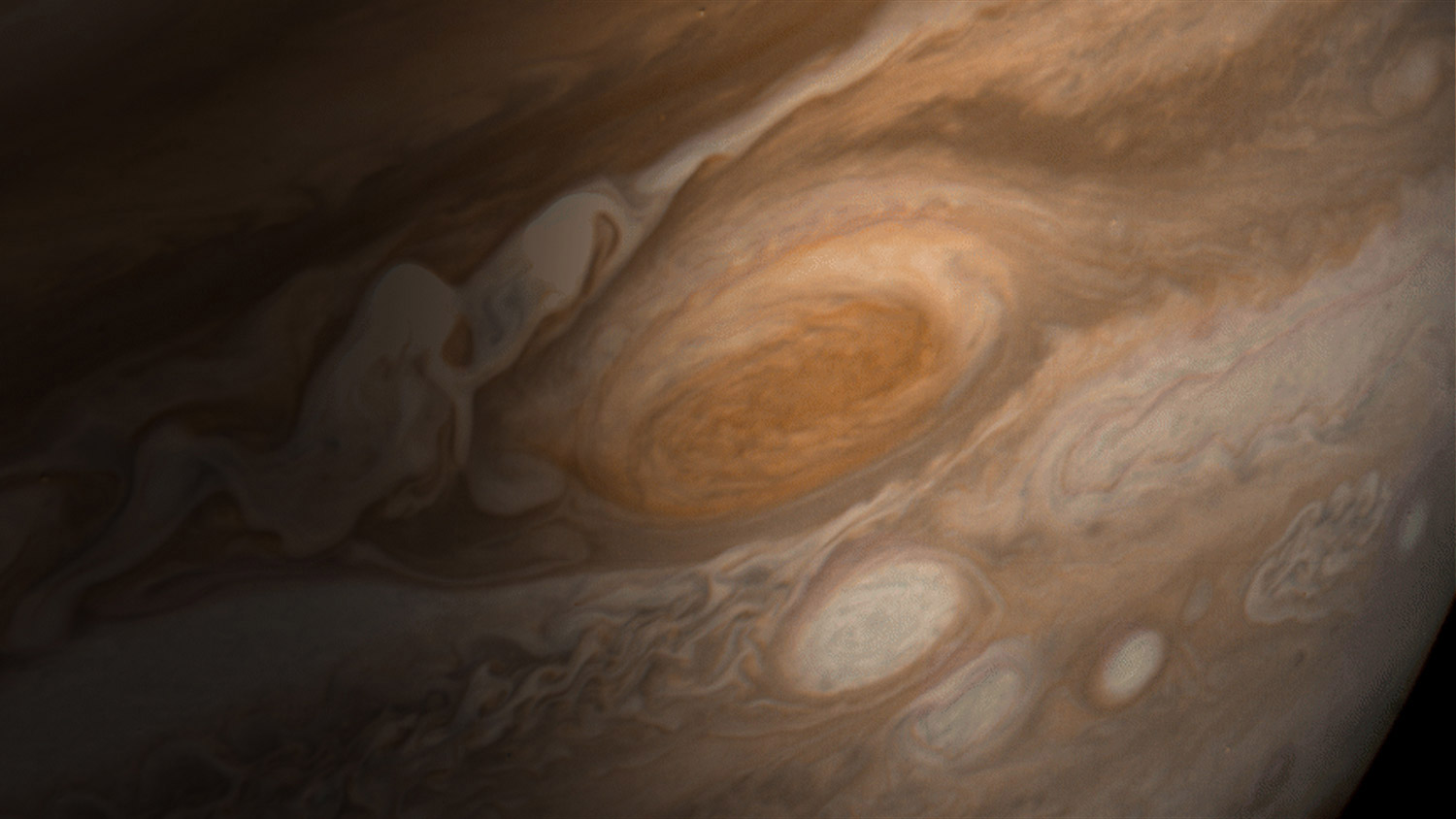
Jupiter and Saturn were thought to be better understood:
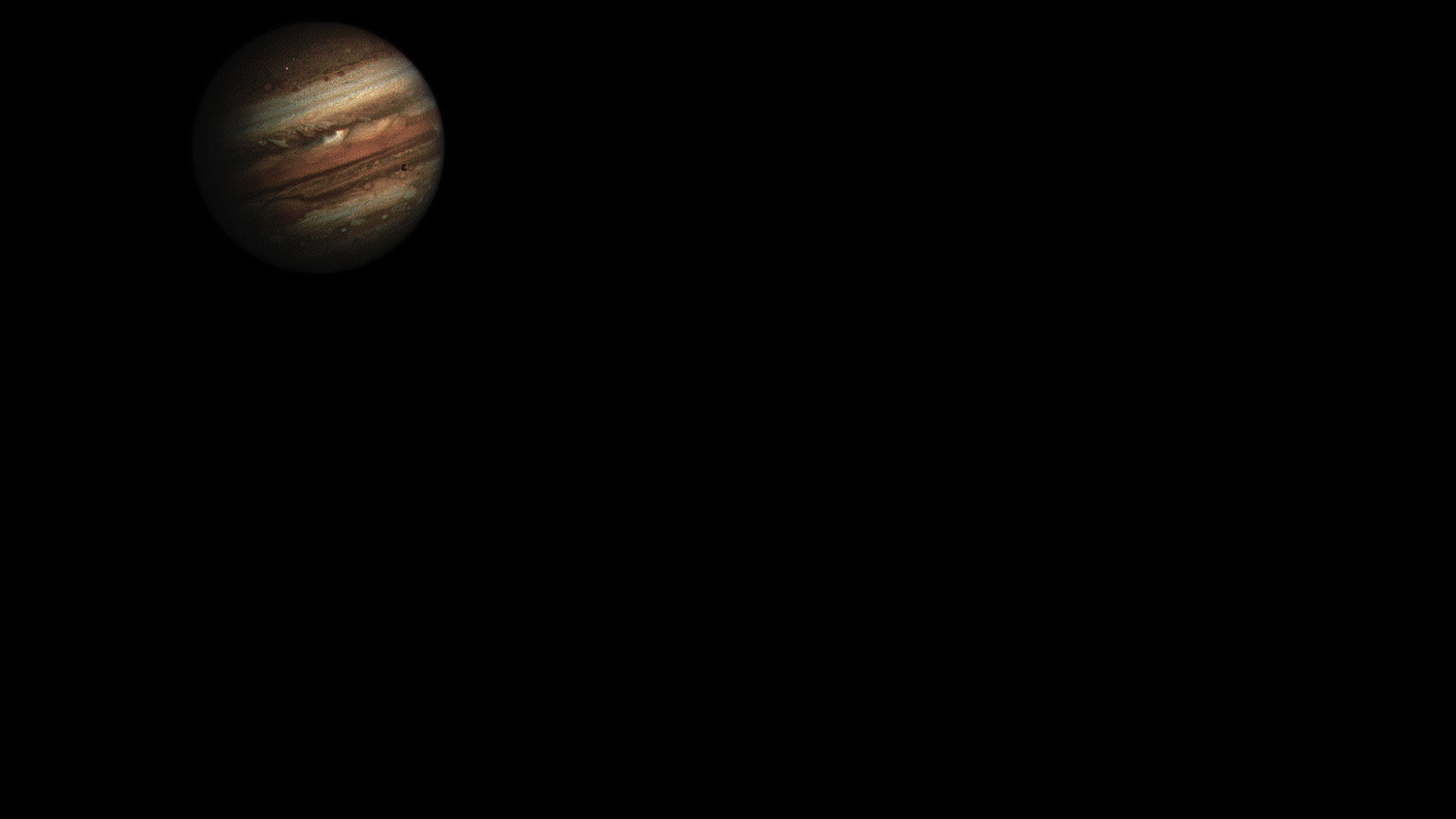
big, boring balls of gas, one adorned with a red spot and surrounded by crater-battered ice moons, the other encircled by uncomplicated rings built of snowballs the size of a Volkswagen minibus.
"We all knew we were going to have a journey of discovery, of course, but none of us knew how rich it was, because none of us had any idea the solar system was so diverse," Stone says.
"Time after time, our 'terra-centric' view was well informed, but it was much too limited," he says, with Earthly expectations confounded by every planet they met.
At Jupiter in 1979, for example, a chance observation upended long-held expectations about Io, Jupiter's innermost large moon, one of the marvels first witnessed by Galileo in 1610.
Planetary scientists had hoped to measure the craters on Io as a way to gauge the impact history of our solar system. Instead, they puzzled over its curiously mottled surface, which resembled nothing so much as an orange left to spoil in the back recess of a refrigerator. Nary a crater was there to be seen.
A chance observation on March 9, 1979, by navigation team member Linda Morabito revealed volcanoes erupting on Io, stunning everyone. "When Voyager was launched, the only active volcanoes known were here on Earth," Stone says. "And suddenly, here's a moon with ten times the volcanic activity of the Earth." All sorts of "funny clues" should have led the scientists to suspect that volcanoes ringed Io, says JPL's Torrence Johnson, but they didn't, in part because of research that pointed toward other possibilities.
For one thing, NASA and University of California planetary scientists had just published a paper in Science suggesting that Io was the "most intensely heated terrestrial-type body in the solar system." Gases were known to come from the moon. And from their own work, the mission team knew that Io's orbit around Jupiter was out-of-round, which might produce heating tides.
Influenced by the Apollo landings, however, the team thought Io was a "dead ringer," Johnson says, for Earth's moon, which had been geologically dead for billions of years.
Expecting to see a moonscape on Io, the team underexposed the first photos sent back from the moon and filtered the images to draw out the expected craters. Which didn't exist.
"We had gotten too clever," Johnson says. The filtering, it turns out, washed out all the plume activity: "a perfect anti-plume filter," he says.
So they initially missed the discovery, until Morabito observed plume shapes visible in overexposed images of the moon taken to provide a fix on guiding stars as Voyager 1 looked back over its shoulder on departure from Jupiter.
"[The plumes] were hitting you right between the eyes," Johnson says, adding dryly: "Of course, we were very imaginative; we named them P1, P2, P3…"
Seven in all. The discovery riveted the public's attention on Jupiter's moons, Galileo's storied discoveries.
 "They had different histories and were worlds in their own right." Some of the volcanoes seen on Io are still smoldering today.
"They had different histories and were worlds in their own right." Some of the volcanoes seen on Io are still smoldering today.
At Saturn in 1981, similar surprises awaited, this time from the planet's seemingly simple rings. "The ring hunt!" Johnson says. "At the time we launched and approached Saturn, it was the A ring, the B ring, the C ring… These are the things you can see from Earth with a telescope. And they were all regarded as being relatively uniform."
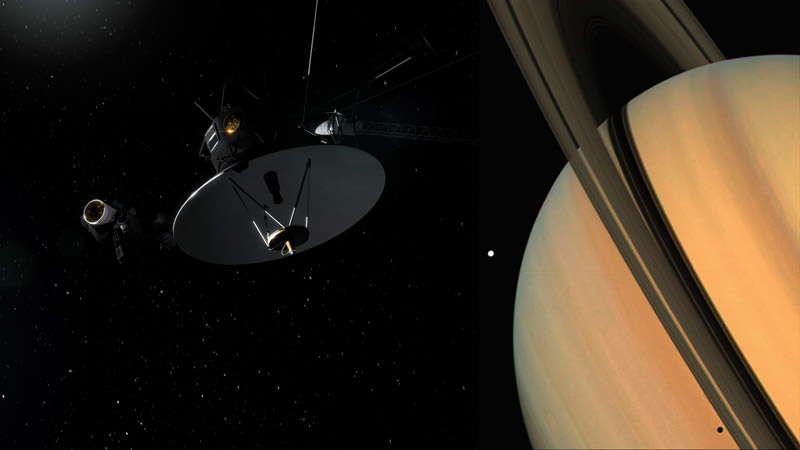

At Saturn in 1981, similar surprises awaited, this time from the planet's seemingly simple rings. "The ring hunt!" Johnson says.

"At the time we launched and approached Saturn, it was the A ring, the B ring, the C ring… These are the things you can see from Earth with a telescope. And they were all regarded as being relatively uniform."
Once again, Voyager's findings surprised. The "gap" in Saturn's rings, discovered in the 16th century, proved to be filled with evenly spaced arcs of dust and ice. Some of the rings possessed spokes, intertwined strands, and "shepherd" moons that watched over unexpected clumps in the outer rings.
Voyager 1 also discovered the thin E ring circling Saturn along the orbit of the mysteriously smooth, icy moon, Enceladus—another puzzle.
The A ring observed for four centuries proved to be, in fact, dozens of ringlets. There were so many that imaging team leader Smith gave up counting them all for reporters at the daily briefing on Voyager 1's Saturn encounter. "You count them," he told the press corps.
Discoveries kept coming. Radio signals sent through the hazy atmosphere of Saturn's big moon, Titan, revealed that the orb's atmosphere was so thick it had fooled astronomers into thinking it was the largest satellite in the solar system. It was actually the second largest at 3,200 miles (5,150 kilometers) wide, some 60 to 70 miles (97 to 113 kilometers) skinnier than Jupiter's frozen moon, Ganymede. (Both are bigger than the planet Mercury.)
The Flybys
"The flybys, that's the time you'd kinda spend living at JPL," Spilker says. People would bring in sleeping bags or stay in campers they kept in the parking lot. "You'd go into offices and there would be these sleeping bags and these legs sticking out 'cause they would be under their desk, sleeping, waiting for the next exciting thing to come down."
With every planetary encounter, every obstacle overcome, every discovery made, the Voyager team grew closer, with picnics and softball games binding them together as a family of sorts. In Spilker's case, the connection was profound.
"I tell my daughters their births were based on the alignments of the planets," Spilker says.
With Voyager 2 leaving Saturn in 1981 and heading for Uranus, a five-year hiatus, she and others on the mission started their families.
"Actually, there is a whole cadre of Saturn-to-Uranus babies who would come with us to the softball games," Spilker says. "They just kind of grew up from being babies to actually playing on the softball team."
Voyager 2's departure from Saturn also saw "one of the toughest times for the team," she says, when the camera-holding platform, or scan platform, of the spacecraft jammed, leaving the cameras and other instruments fruitlessly clicking away on empty space instead of their intended targets.
"We realized: Oh, my gosh, we're stuck," says Spilker. "This is terrible."
(Among the opportunities lost was a chance to see the geysers we now know erupt from the underside of Enceladus, creating Saturn's E ring, and spokes in the other rings that would await discovery by the Cassini mission two decades later. The mission also lost a chance to shoot a photo strip of the northern half of the moon Tethys.)
 Once
again the mission was in danger. Voyager 2 was flying toward Uranus
with its eyes fixed in one direction. Half of the Grand Tour was at
stake.
Once
again the mission was in danger. Voyager 2 was flying toward Uranus
with its eyes fixed in one direction. Half of the Grand Tour was at
stake.
"The thing I was concerned about was the scan platform was pointed in a position looking past the planet, into space," says astronomer Ellis Miner, who was the assistant project scientist for Voyager, Stone's right-hand man. "Immediately, I started thinking of a way to turn it to look back at the planet."
Once again, some luck helped.
After two anxious days of trying, the engineering team discovered that very slow, stronger-than-normal turns of the scan platform allowed low-speed pointing of the cameras. They would be able to get pictures of Uranus and Neptune after all.
"We probably caused the problem," Miner says now. After Voyager 1's flight past Saturn, the team had sped up operations of Voyager 2's scan platform to take even more pictures. The rapid motions likely caused the platform's bearings to seize. Slow, careful motions seemed to work just fine, preserving plans for Uranus and Neptune.
"It would have been a whole lot better if it had been Voyager 1 that had seized at Saturn, because that was its last planetary encounter," he says.
Uranus and Neptune, of course, were always in the plans for Voyager 2, but it wasn't until Voyager 1 carefully observed the haze-shrouded mini-world Titan, Saturn's largest moon, "an enigma," Miner said, that NASA headquarters released Voyager 2 for the rest of the Grand Tour.
"Voyager was the last of the big missions that really did not have a funding problem," Miner adds. "It was so successful that when we went back to them with a request for some money to accomplish some specific thing, almost invariably they would grant it. That's unheard of in the space program."
Already a great success, Voyager 2 arced toward Uranus, while Voyage 1 pursued a faster path out of the solar system.
Uranus
Voyager 2 would be Earth's first visitor to Uranus. At the time, little was known about the planet, the fourth largest world in the solar system, except that it was cold, aquamarine, and encircled by its own thin, dark rings. Scientists knew that it rotated on its side with its south pole facing the sun, but didn't know how fast it spun.
Voyager 2 arrived at Uranus in 1986, a fateful year for NASA.
The spacecraft's closest encounter with Uranus, 50,600 miles (81,500 kilometers) above its blue clouds, would come on January 24, only four days ahead of the space shuttle Challenger disaster, which killed seven astronauts: Mike J. Smith, Francis R. (Dick) Scobee, Ronald E. McNair, Ellison S. Onizuka, Sharon Christa McAuliffe, Gregory Jarvis, and Judith A. Resnik.
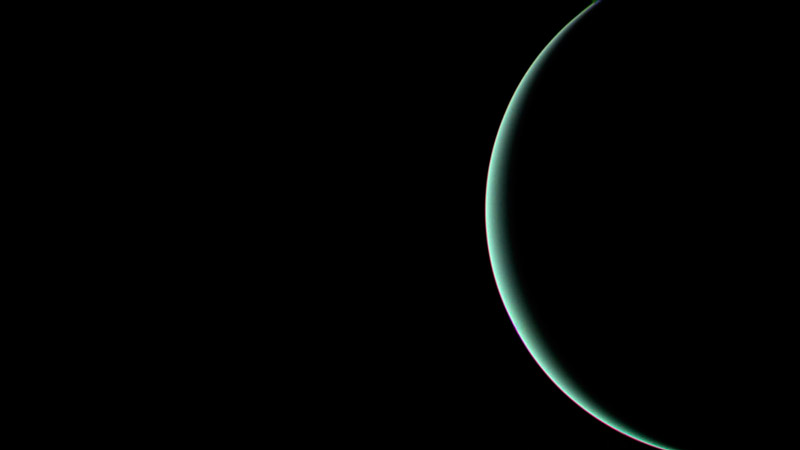
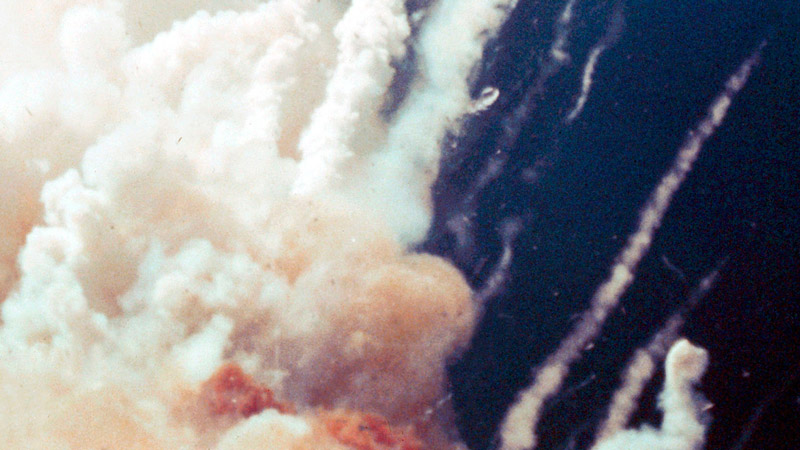

The spacecraft's closest encounter with Uranus, 50,600 miles (81,500 kilometers) above its blue clouds, would come on January 24,

only four days ahead of the space shuttle Challenger disaster, which killed seven astronauts: Mike J. Smith, Francis R. (Dick) Scobee, Ronald E. McNair, Ellison S. Onizuka, Sharon Christa McAuliffe, Gregory Jarvis, and Judith A. Resnik.

The spacecraft's closest encounter with Uranus, 50,600 miles (81,500 kilometers) above its blue clouds, would come on January 24,

only four days ahead of the space shuttle Challenger disaster, which killed seven astronauts: Mike J. Smith, Francis R. (Dick) Scobee, Ronald E. McNair, Ellison S. Onizuka, Sharon Christa McAuliffe, Gregory Jarvis, and Judith A. Resnik.
The Voyager team had ended its science meetings early that day to see the launch on television, only to watch in stunned silence as the disaster unfolded. "It was terrible," Miner says. With the entire space agency in mourning, Voyager briefings were canceled.
The briefings resumed two days later. "It was such bad news for NASA that the emphasis was on the great results from Uranus to take away from the sorrow of the death of the astronauts," Miner says. "It was the only good news that NASA had."
The unexpected star of the Uranus encounter was the planet's smallest major moon, Miranda, "the most bizarre body in the solar system," according to JPL's The Voyager Neptune Travel Guide. Astronomers had expected the moon, discovered in 1948, to be a crater-strewn ice ball. The moon was heavily cratered, but it was also cut by deep cliffs and adorned with three grooved, racetrack-shaped plains that met in chevron shapes, as if giants had chiseled hundred-mile slabs of ice off its face.
Planetary scientists now believe that Miranda escaped a tidal lock it had with another of Neptune's moons, which had wracked and heated its icy interior to produce its strange surface.
Uranus also proved to have a magnetic north pole that pointed upward, toward its equator, and was off-center, another puzzle.
 "Each
encounter invariably brought some surprises," Miner says. "It was our
observation that we didn't know these planets nearly as well as we
thought we did."
"Each
encounter invariably brought some surprises," Miner says. "It was our
observation that we didn't know these planets nearly as well as we
thought we did."
Neptune, the last planet on Voyager's Grand Tour, was finally ready for its close-up in 1989. It was both a "first look and a final farewell," as National Geographic's Rick Gore wrote that year.
Voyager found a cobalt-colored world whose serene face hid winds of 1,242 miles (2,000 kilometers) per hour, the fastest yet seen on any planet.
 Its large moon, Triton, was covered with creeping frost and slush from ice volcanoes timed to the change of seasons.
Its large moon, Triton, was covered with creeping frost and slush from ice volcanoes timed to the change of seasons.
Most likely, the team concluded, Triton was a refugee from the comet belt, an ice ball that had been captured long ago by Neptune's gravity.
Once again, Voyager opened the minds of scientists and the public to the vast variety of our solar system. No longer just points of light, every world, every moon had its own story to tell.
"It changed entirely planetary science," Miner says. "Planetary science became more like geology."
From the start, Stone had built a science team that worked cooperatively to squeeze as much science as possible out of each planetary encounter. Instrument teams competed for time to look at what they could argue was most scientifically compelling on each day of each encounter. It was a surprisingly harmonious enterprise that Miner explains was largely the result of the JPL engineering team's creativity in satisfying the scientists' demands for ever more observations.
"Many times somebody won and somebody lost," Miner says. "But we generally had so many chances we could give them their second chance."
The Pale Blue Dot
As a planetary finale, at the behest of imaging team scientist Carl Sagan, the Voyager turned its cameras backward and, pointing in the direction of our home some 3.7 billion miles (5.9 billion kilometers) away, shot 60 images of the solar system.
Among them was the famous "pale blue dot" photo, showing the Earth as a tiny glint in the vastness of space. The image made real to everyone, Sagan said, what Galileo knew, what Copernicus knew, and what the women and men of Voyager knew in their bones—that we live on a tiny world, a lonely speck in the darkness.
"On it everyone you love, everyone you know, everyone you ever heard of, every human being who ever was, lived out their lives," Sagan wrote. "To me it underscores our responsibility to deal more kindly with one another, and to preserve and cherish the pale blue dot, the only home we've ever known."
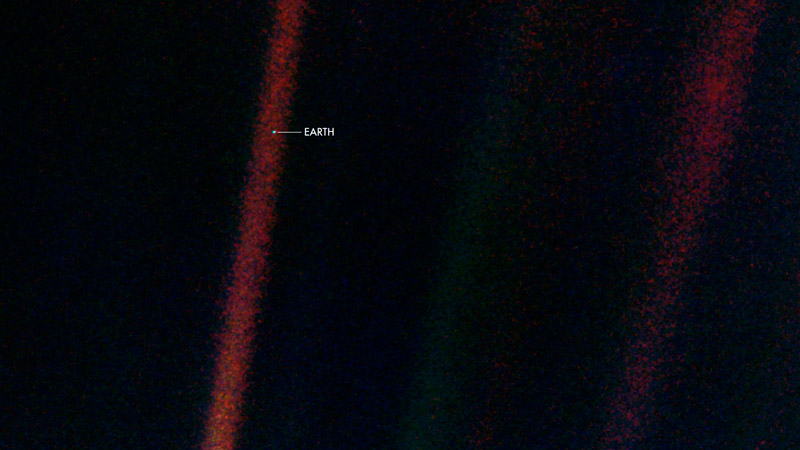

"On it everyone you love, everyone you know, everyone you ever heard of, every human being who ever was, lived out their lives," Sagan wrote.

"To me it underscores our responsibility to deal more kindly with one another, and to preserve and cherish the pale blue dot, the only home we've ever known."
Interstellar Ambassador
On its flyby of Neptune, Voyager 2 skimmed over the northern half of that world, poised for a close look at Triton. The gravitational pull of the planet bent the spacecraft's path southward as it headed out of the solar system at 33,100 miles (53,400 kilometers) per hour.
Years earlier, Voyager 1 had similarly passed somewhat "beneath" Saturn when it took its close look at its moon Titan. As a result, it had headed outbound on a trajectory aimed in a northerly direction, zipping along at an even faster 37,500 miles (60,000 kilometers) per hour. The two spacecraft soon outpaced their slower predecessors, Pioneer 10 and Pioneer 11, the very first spacecraft to visit the outer planets.
For Voyager, it wasn't the end. But on Earth, the end of the Neptune encounter meant farewell for the Voyager team at JPL. Many of them moved on to the next generation of Jupiter spacecraft, the Galileo mission, or the Saturn explorer, Cassini.
After more than a decade of exploring worlds and triumphing over showstopping challenges, "we'd developed a camaraderie, more like a family than co-workers," Miner says.
"We all had the same goal," Spilker says. "We were explorers out there wanting to do the best we could, knowing we were going to see new things."
The Interstellar Mission
In 1990, Voyager 1 and Voyager 2 started their "interstellar mission." In a modern-day version of finding the source of the Nile, the spacecraft sought the edges of the solar wind.
"The theory for 50 years was that it had to end somewhere," says Voyager team scientist Donald Gurnett of the University of Iowa in Iowa City, who headed one instrument team. "We just didn't know where."
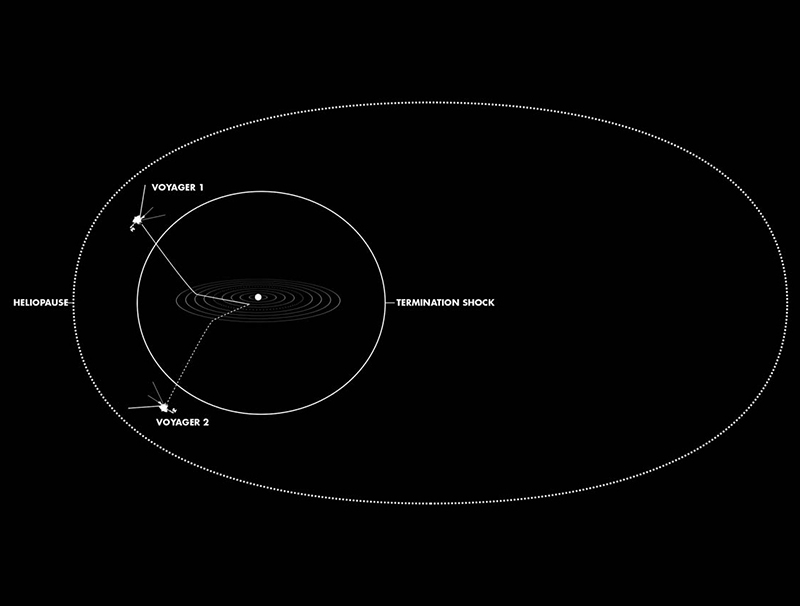
Past the planets, the Voyager spacecraft aim to explore interstellar space, by first crossing the "termination shock," where the solar wind slows abruptly, and then heading past the "heliopause," where the solar wind and interstellar wind meet.







Past the planets, the Voyager spacecraft aim to explore interstellar space, by first crossing the "termination shock," where the solar wind slows abruptly, and then heading past the "heliopause," where the solar wind and interstellar wind meet.
The endeavor pitted the fading plutonium battery power of the spacecraft against the strength of the sun's solar wind.
Over time, radioactive decay meant that the battery power needed to operate the spacecraft's instruments was fading, from 475 watts at launch to 370 watts by the time Voyager 2 reached Neptune.
That wasn't a big deal initially, when Voyager 1 and Voyager 2 headed off on their interstellar mission. They no longer needed their power-hungry cameras, says Voyager project manager Suzanne Dodd. Dodd still heads the team of about a dozen JPL engineers carefully apportioning the juice left aboard each spacecraft. The spacecraft each lose about 4 watts of power a year.
The Voyager team chewed on a vexing question: Would the spacecraft find the edge of the solar wind before they ran out of the battery power needed for their instruments to make the discovery? The edge of the solar wind was an estimated 50 to 150 times the distance of the Earth from the sun; in comparison, Neptune orbited at 30 times that distance.
So, Voyager 1 and Voyager 2 had a ways to go.
The solar wind flows outward from the sun traveling at one million miles (1.6 million kilometers) per hour, made up of energetic particles blasted off the solar surface and into space, where the wind surrounds our star like a bubble.
In 2004, Voyager 1 entered the boundary region between the solar wind and the interstellar wind. Almost yearly, the team reported signs the spacecraft was edging closer to true interstellar space.
Making matters more complicated, however, was the breakdown in 1980 of an instrument for directly detecting that transition, which forced mission scientists to rely on indirect signs of Voyager 1 crossing into interstellar space.
Once again, the Voyager team needed to find a clever solution to their problems.
The big break came from a pair of solar storms, powerful outbursts from the sun, which caught up to the spacecraft in October 2013 and then again in April of this year. The instrument that Gurnett's team operated aboard the spacecraft, essentially a radio receiver called the plasma wave subsystem, was too weak to detect the interstellar wind. But it could measure the effects of a powerful solar storm interacting with its environment as it overtook the spacecraft.
In a report published in Science in September 2013, Gurnett's team reported that measured changes in electrical activity around Voyager did indeed correspond to interstellar space, roughly 40 times more dense than the solar wind. Based on the storm's revelations, the team extrapolated the entry date for Voyager 1 into interstellar space as August 25, 2012.
Voyager 1 delivered one last surprise, this one about our galaxy. Its data showed that the Milky Way's magnetic field is apparently aligned in the same direction as the sun's, forming what Stone calls a "magnetic highway." Space scientists had generally assumed that the galaxy's magnetic field would have some other direction.
That explained why scientists had been unable to use magnetic readings to find the edge of the solar wind and determine a starting line for interstellar space, which turned out to be nearly 125 times farther from the sun than Earth is, at 11.7 billion miles (18.8 billion kilometers). (A few scientists argue that a "magnetic reversal" will still take place for Voyager 1 before 2016. Stone and his team said they will watch for the signal, but stand by the 2012 estimate.)
How good was the Voyager science team? In their 1989 Voyager Neptune Travel Guide, produced for the last planetary encounter, they predicted that Voyager 1 would reach "mare incognito—the interstellar medium" in 2012. They nailed it, with a prediction made at a time when no one knew the distance for certain.
"It takes smart people to run a smart spacecraft," Stone says now.
Voyager 1 and Voyager 2 still have time to make a few more discoveries before their battery power fades out around 2025.
Early in July, for example, Voyager 1 recorded more "tsunami waves" from solar storms in interstellar space, electrical rumblings lashing out past the edges of the solar wind.
"This really is a first step for our human journey beyond Earth, beyond the planets—in fact, into interstellar space,"
Stone told comedian Stephen Colbert on his television show The Colbert Report last December. At the show's climax, Colbert (dressed in a space suit) presented Stone with NASA's Distinguished Public Service Medal, its highest award for someone outside the agency. Pressed by Colbert on the fate of the two spacecraft after 2025, Stone said the Voyager spacecraft "will be our silent ambassadors."
But in truth, of course, both spacecraft have already spoken
loudly. Centuries in the making, their voyage of discovery will echo and
resound, recalled forever as humanity's first journey to the edge of
the solar system, and beyond. 
CREDITS
PRODUCED & DESIGNED BY
morel
MUSIC AND SOUND DESIGN BY
Tyler Strickland
RESEARCH BY
Kelsey Nowakowski
PHOTOGRAPHS BY
Ron Galella/WireImage/Getty Images (Kennedys);
CBS via Getty Images (Elvis);
Michael Ochs Archives/Handout/Getty Images (Saturday Night Fever);
NASA/JPL (Voyager 1);
NASA/National Geographic (Golden Record);
Time Life Pictures/NASA/The LIFE Picture Collection/Getty Images (Voyager 1);
NASA/JPL (Voyager 2);
NASA/JPL (Voyager 1);
Universal History Archive/Getty Images (Galileo Galilei);
Universal History Archive/Getty Images (Johannes Kepler);
NASA (moon landing video);
NASA (Jupiter, Pioneer 10);
NASA/JPL-Caltech (Linda Spilker);
NASA/JPL (Jupiter's Red Spot);
NASA/JPL (Jupiter);
NASA/Johns Hopkins University Applied Physics Laboratory/Southwest Research Institute (Giant plume from Io's Tvashtar volcano);
NASA/JPL (Saturn);
NASA/JPL (Uranus, first image);
NASA/JPL (Uranus, second image);
Apic/Getty Images (Challenger);
NASA/JPL-Caltech (Uranus's moon, Miranda);
NASA/JPL (Triton video);
NASA/JPL (Earth dot);
NASA/National Geographic (Earth). Audio courtesy Miller Center (Jimmy Carter).


"Perhaps
some future deep space explorers will catch up with Voyager, our first
interstellar envoy, and reflect on how this intrepid spacecraft helped
enable their journey."
— John Grunsfeld, NASA's associate administrator for science in Washington
| CREDITS | |
| PRODUCED & DESIGNED BY | morel |
| MUSIC AND SOUND DESIGN BY | Tyler Strickland |
| RESEARCH BY | Kelsey Nowakowski |
| PHOTOGRAPHS BY | |
| Ron Galella/WireImage/Getty Images (Kennedys);
CBS via Getty Images (Elvis); Michael Ochs Archives/Handout/Getty Images (Saturday Night Fever); NASA/JPL (Voyager 1); NASA/National Geographic (Golden Record); Time Life Pictures/NASA/The LIFE Picture Collection/Getty Images (Voyager 1); NASA/JPL (Voyager 2); NASA/JPL (Voyager 1); Universal History Archive/Getty Images (Galileo Galilei); Universal History Archive/Getty Images (Johannes Kepler); NASA (moon landing video); NASA (Jupiter, Pioneer 10); NASA/JPL-Caltech (Linda Spilker); NASA/JPL (Jupiter's Red Spot); NASA/JPL (Jupiter); NASA/Johns Hopkins University Applied Physics Laboratory/Southwest Research Institute (Giant plume from Io's Tvashtar volcano); NASA/JPL (Saturn); NASA/JPL (Uranus, first image); NASA/JPL (Uranus, second image); Apic/Getty Images (Challenger); NASA/JPL-Caltech (Uranus's moon, Miranda); NASA/JPL (Triton video); NASA/JPL (Earth dot); NASA/National Geographic (Earth). Audio courtesy Miller Center (Jimmy Carter). |
|